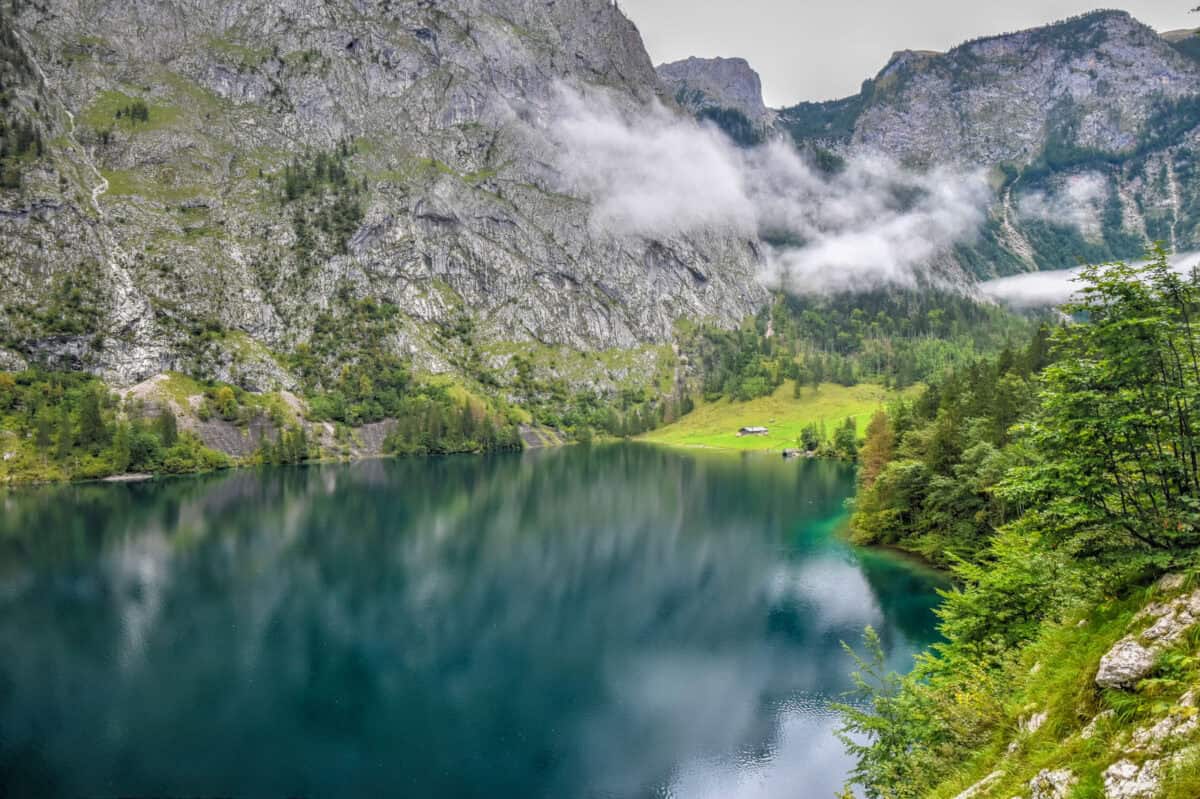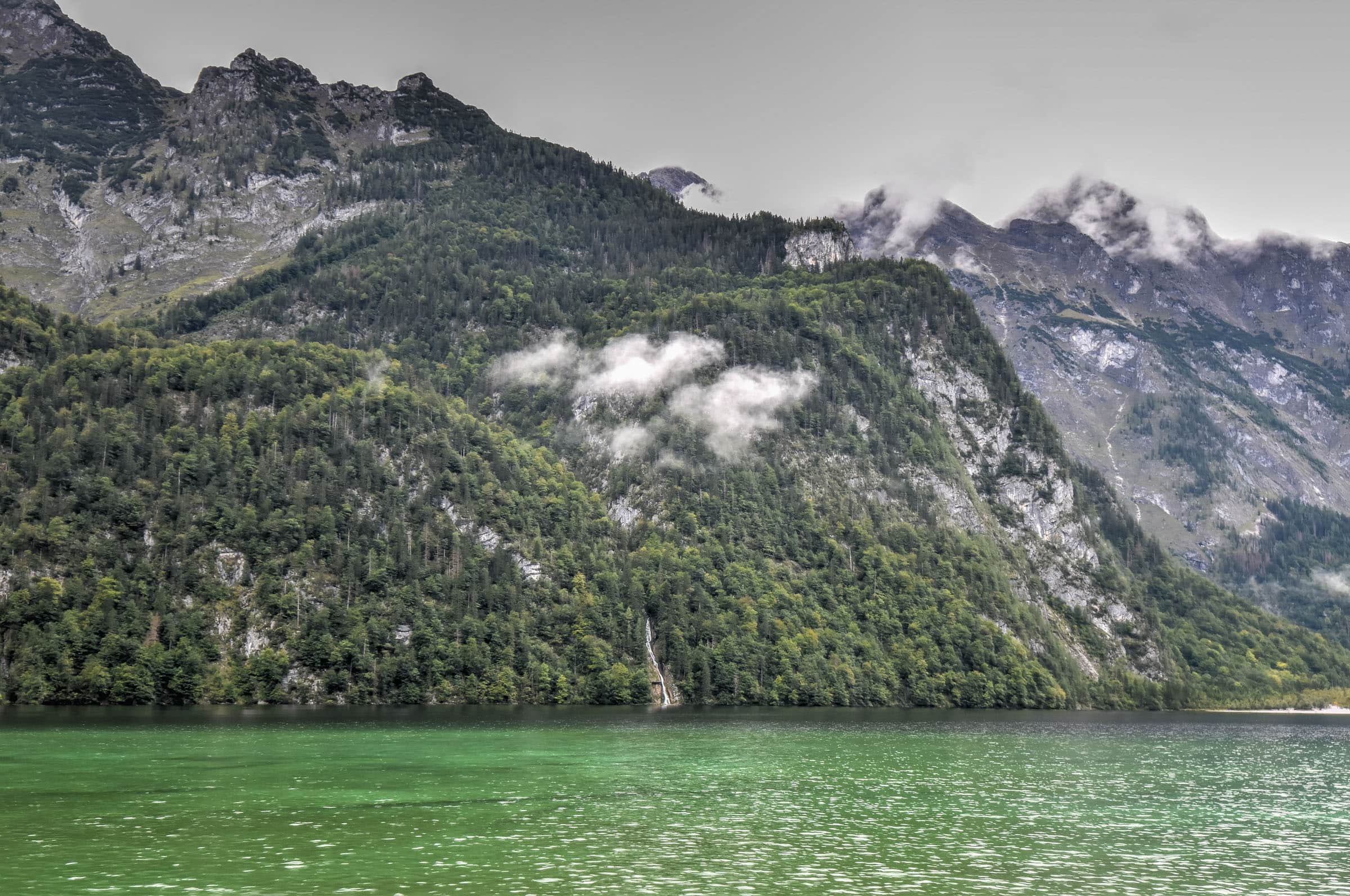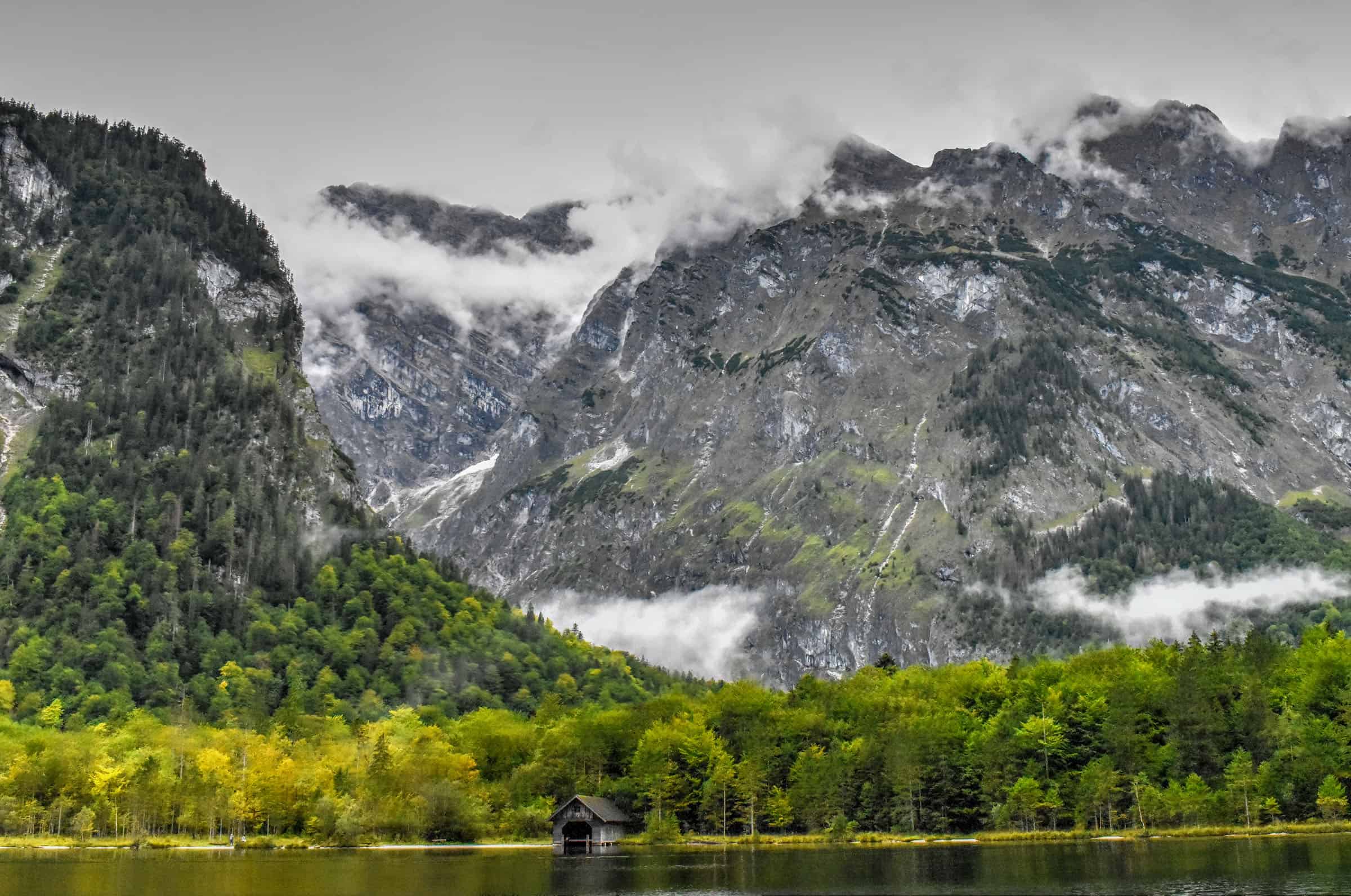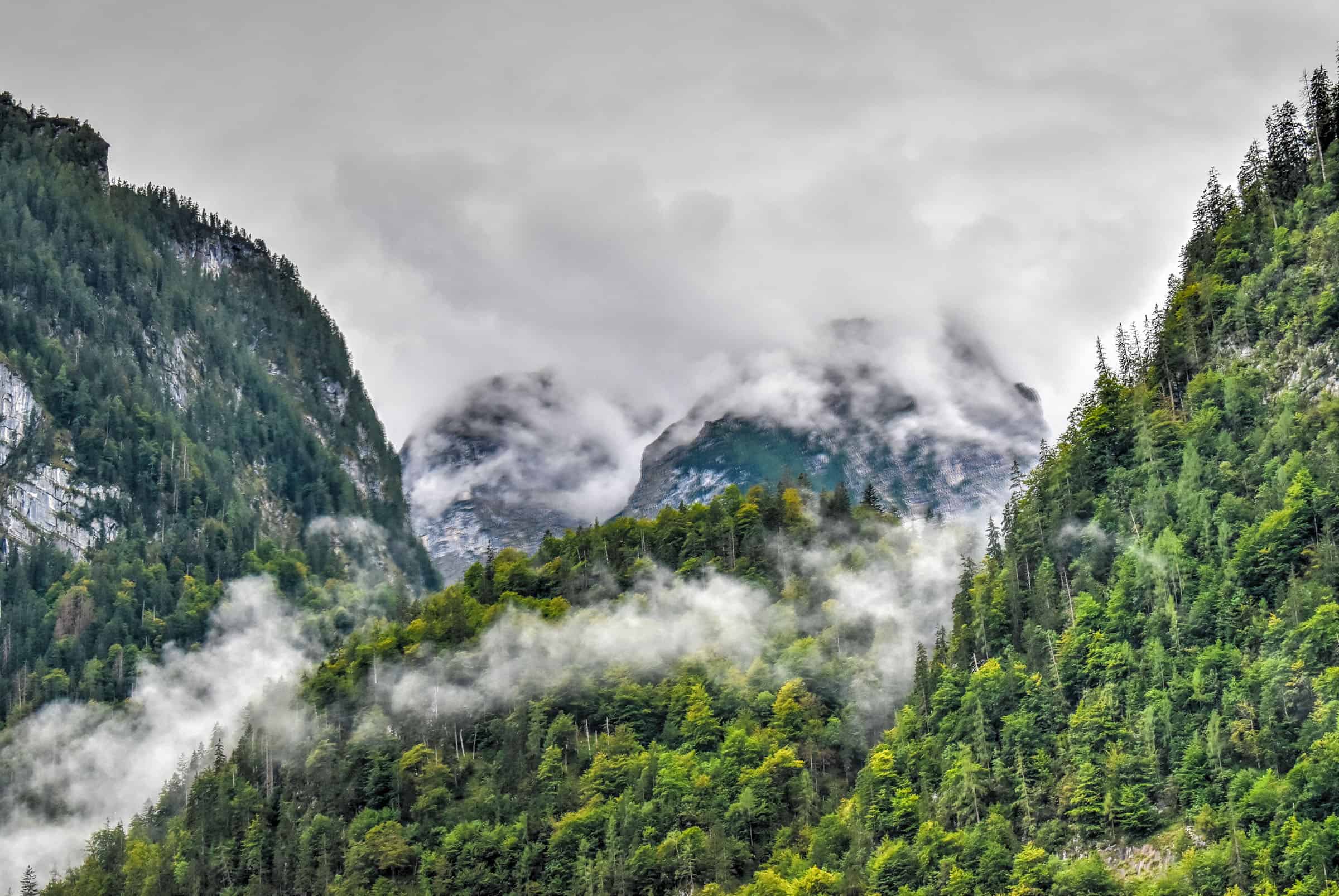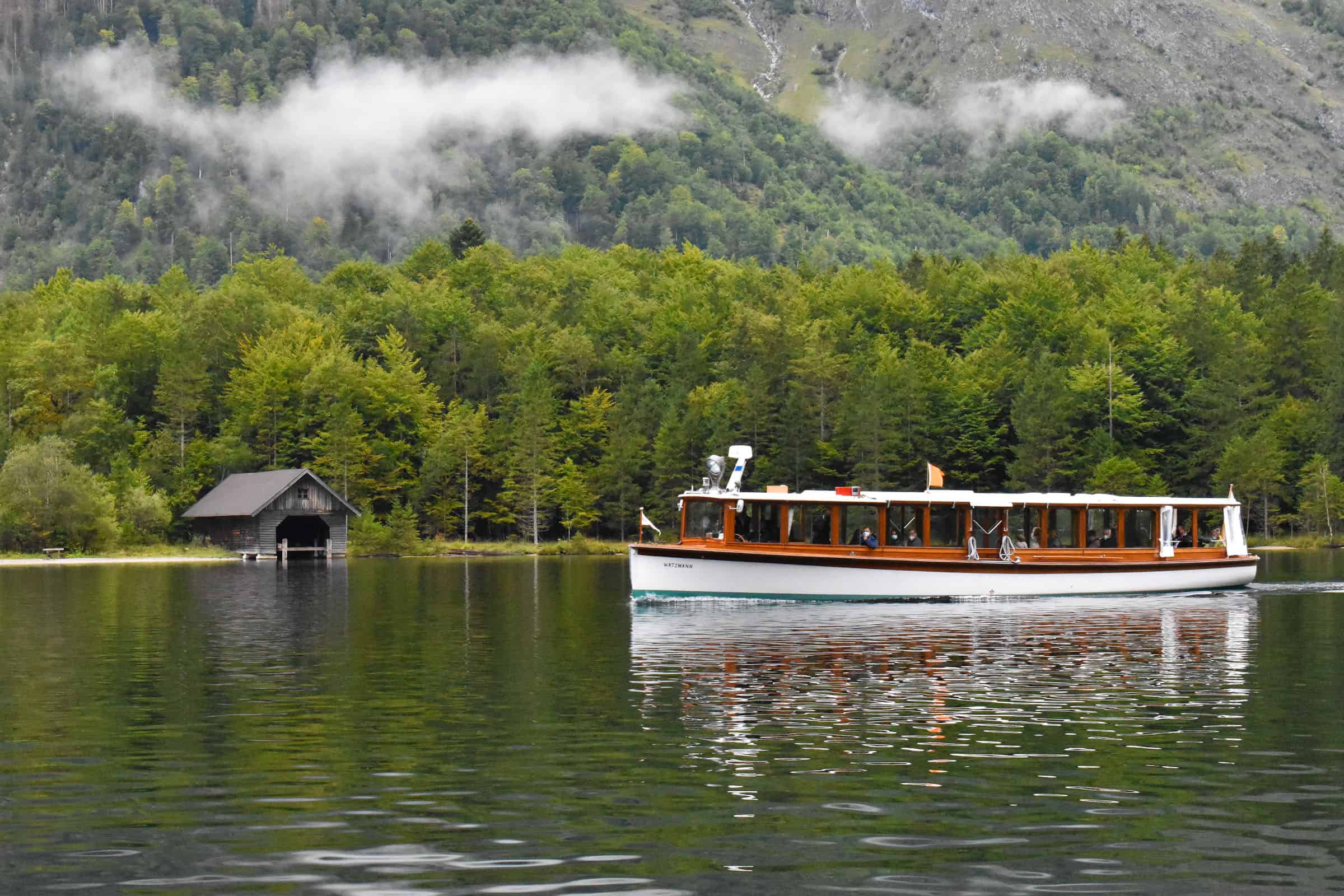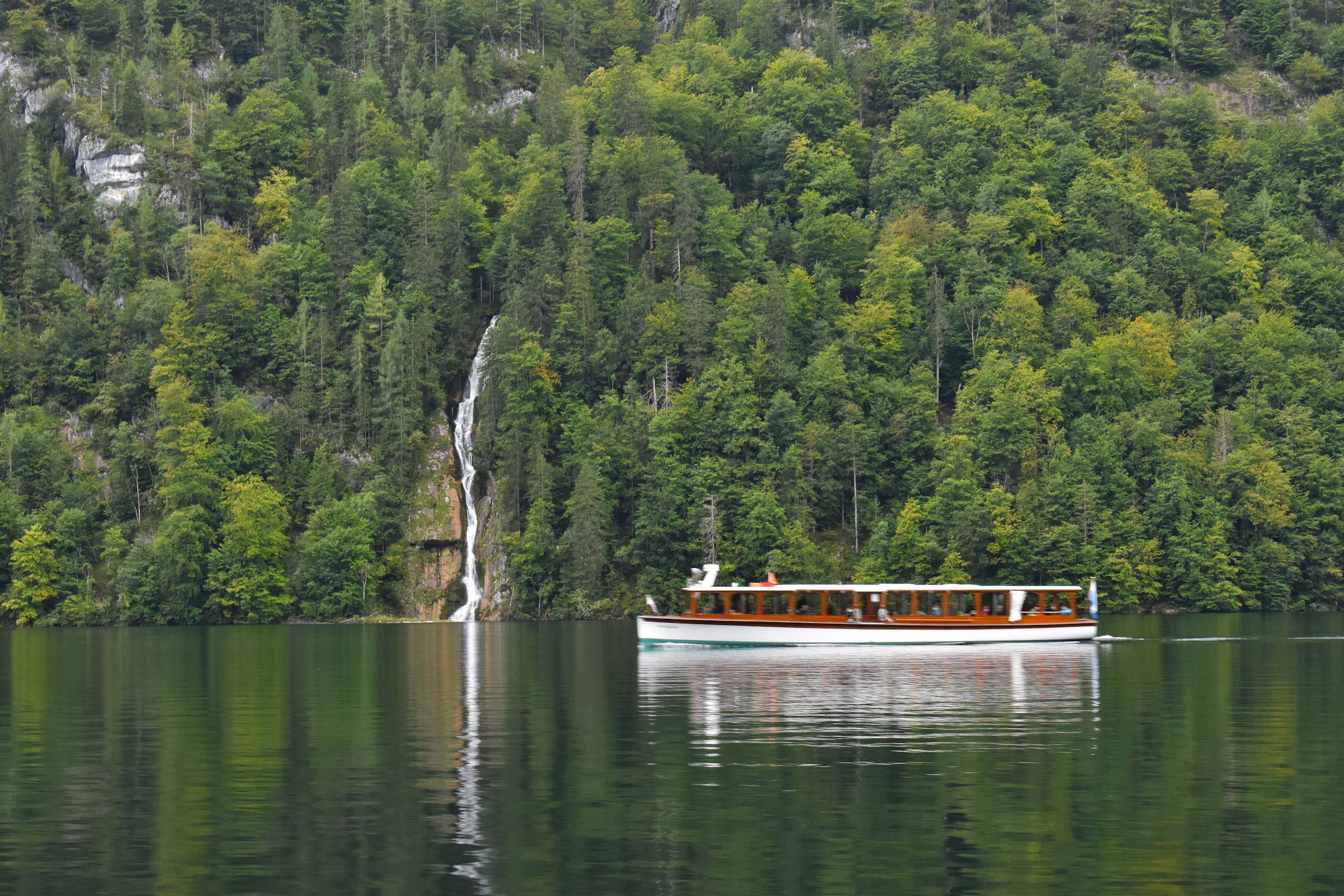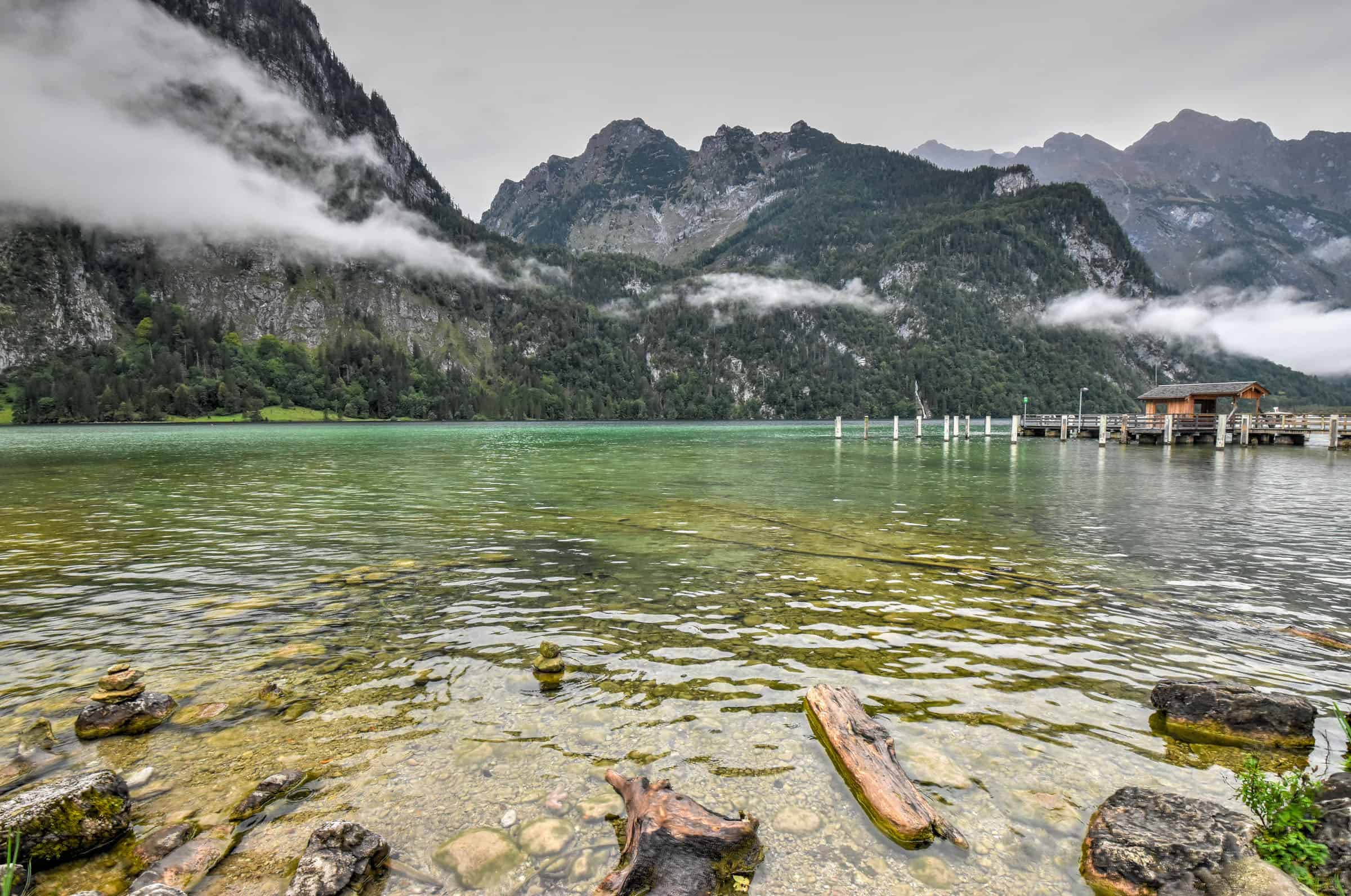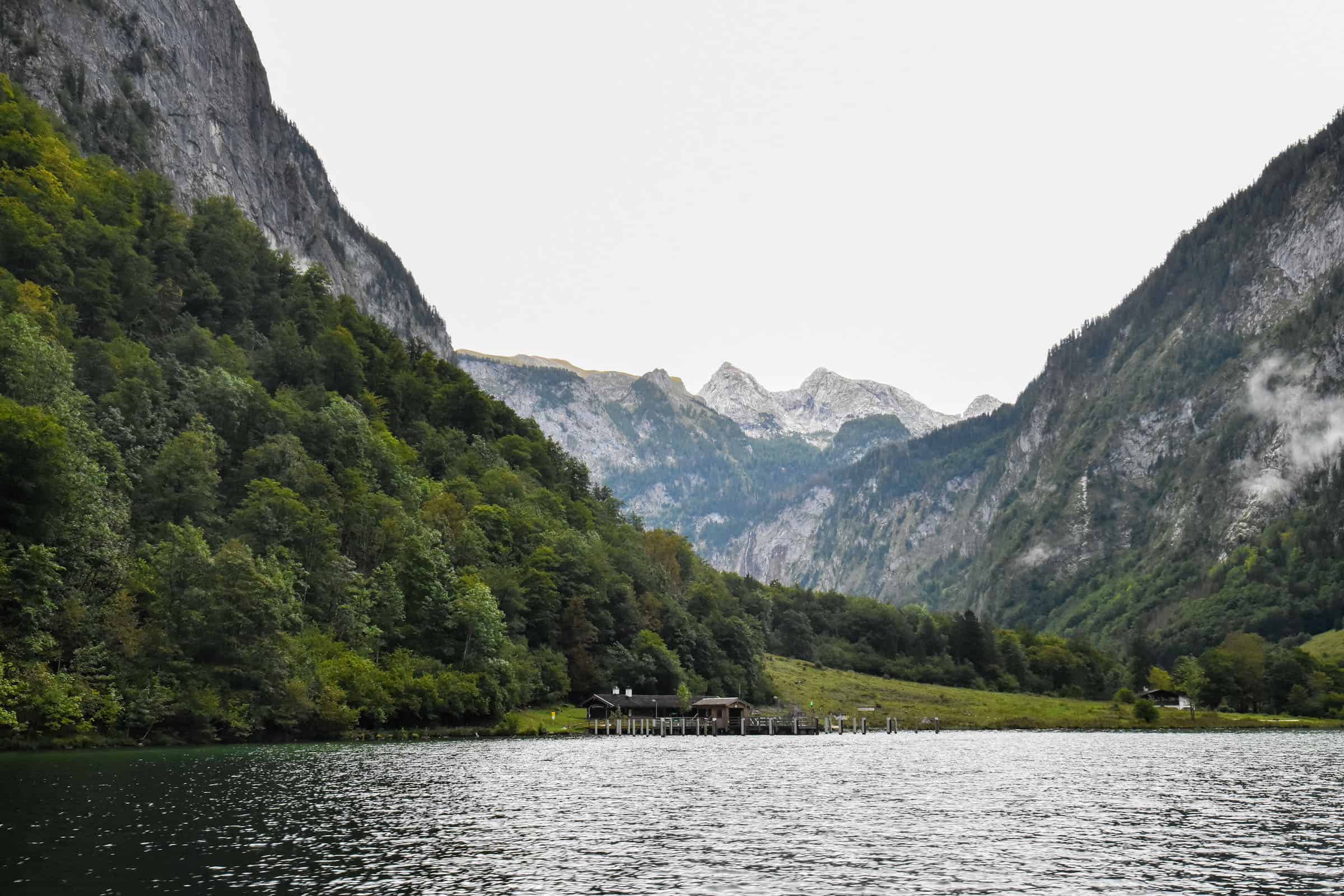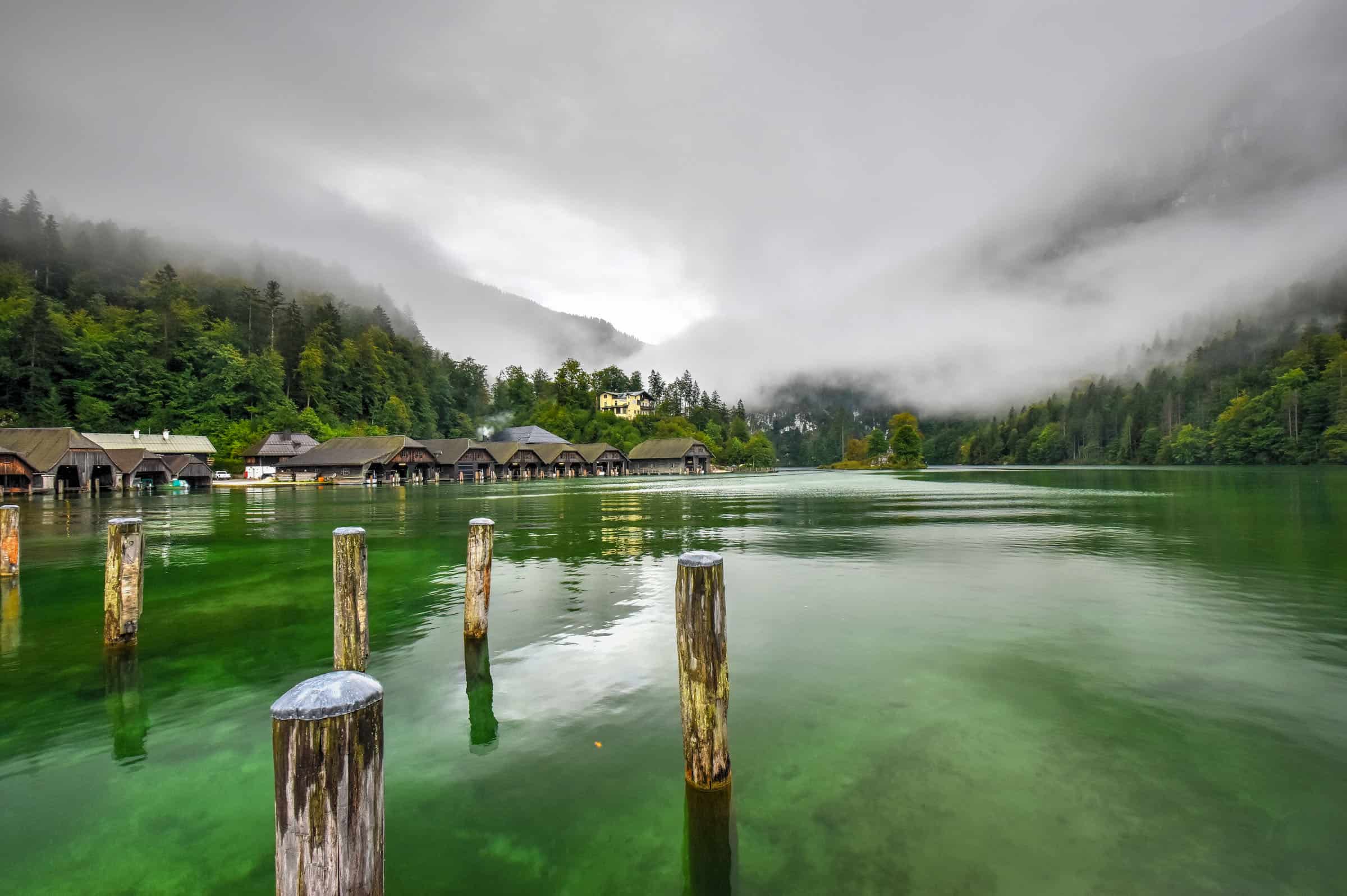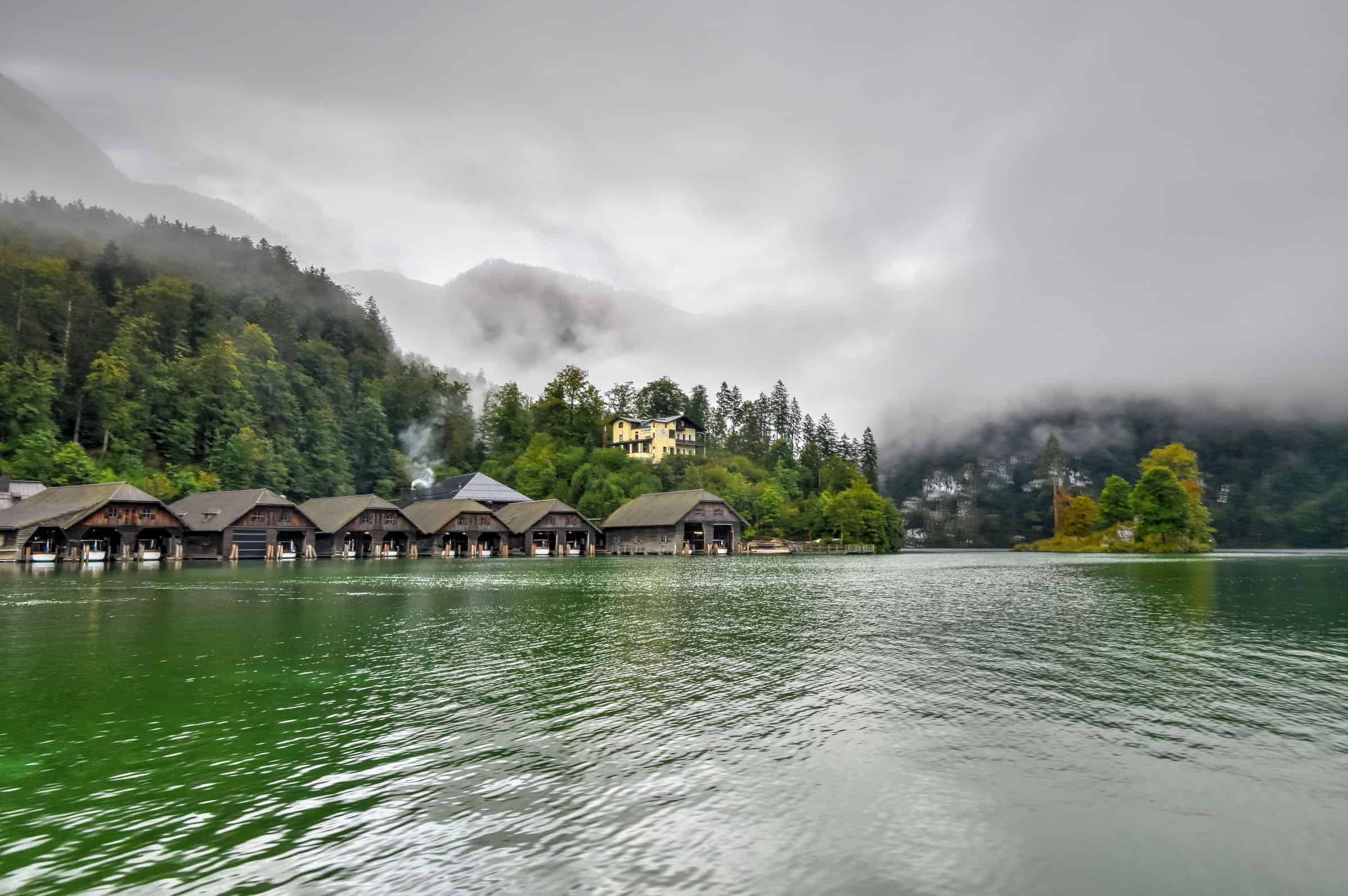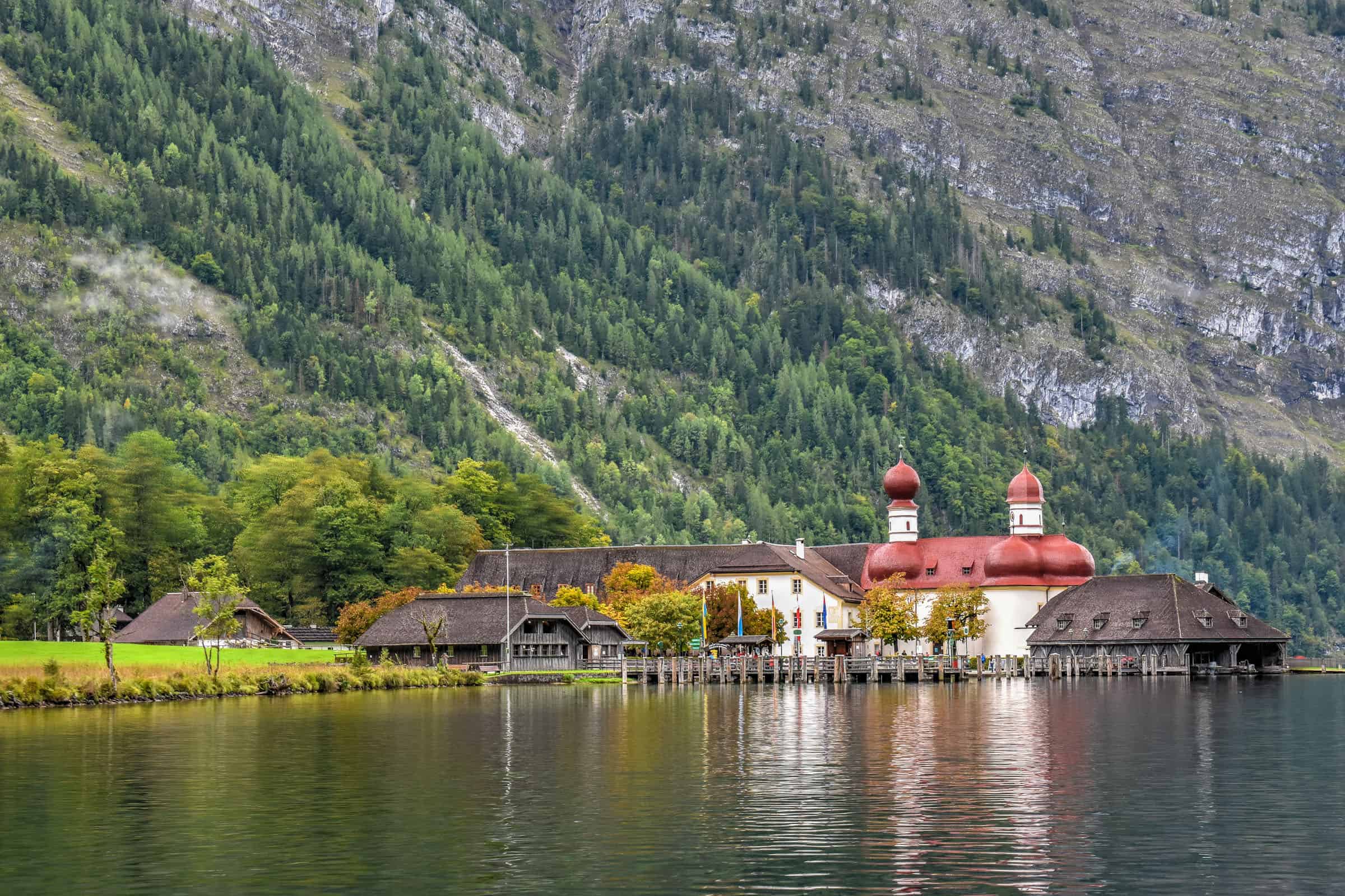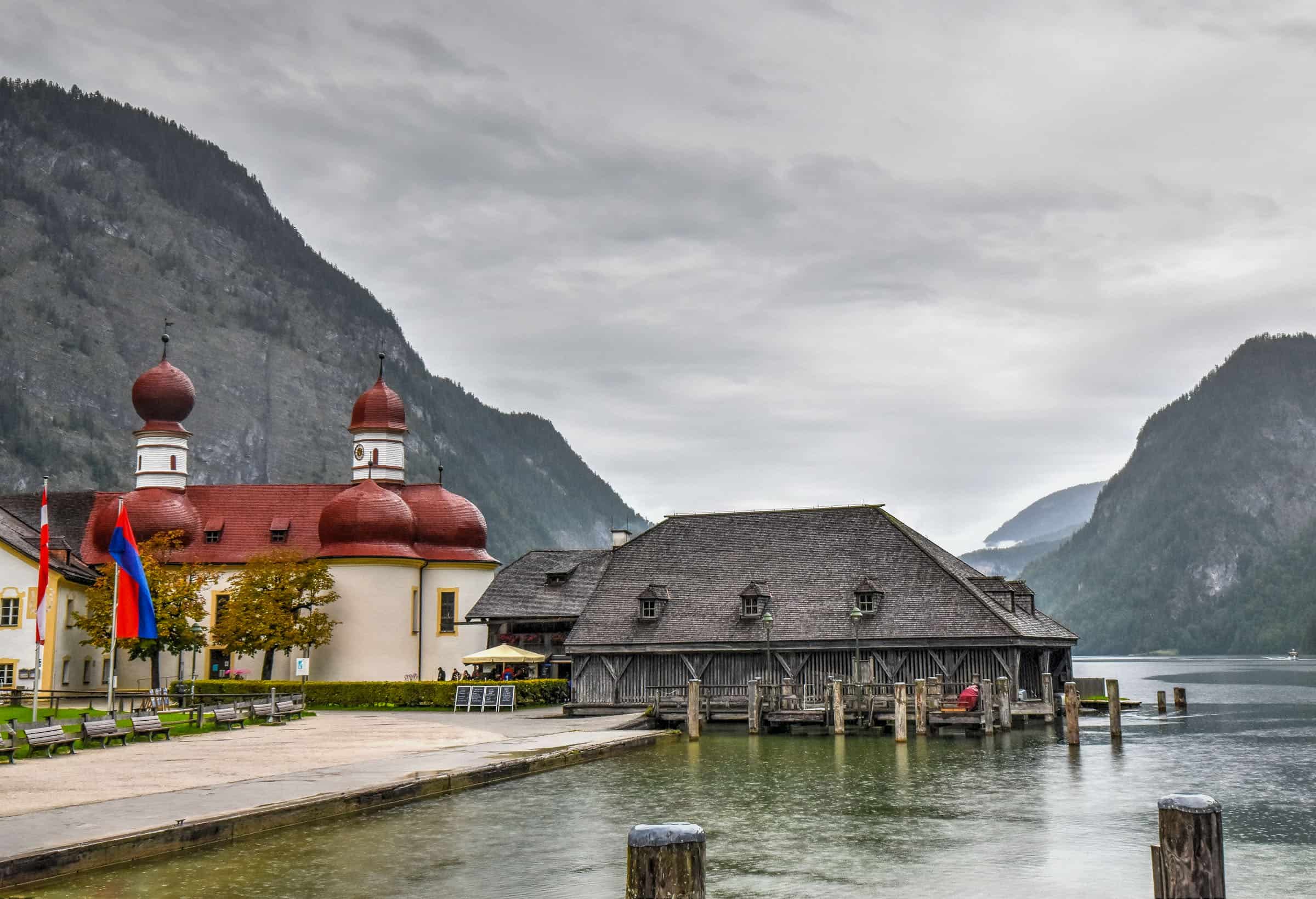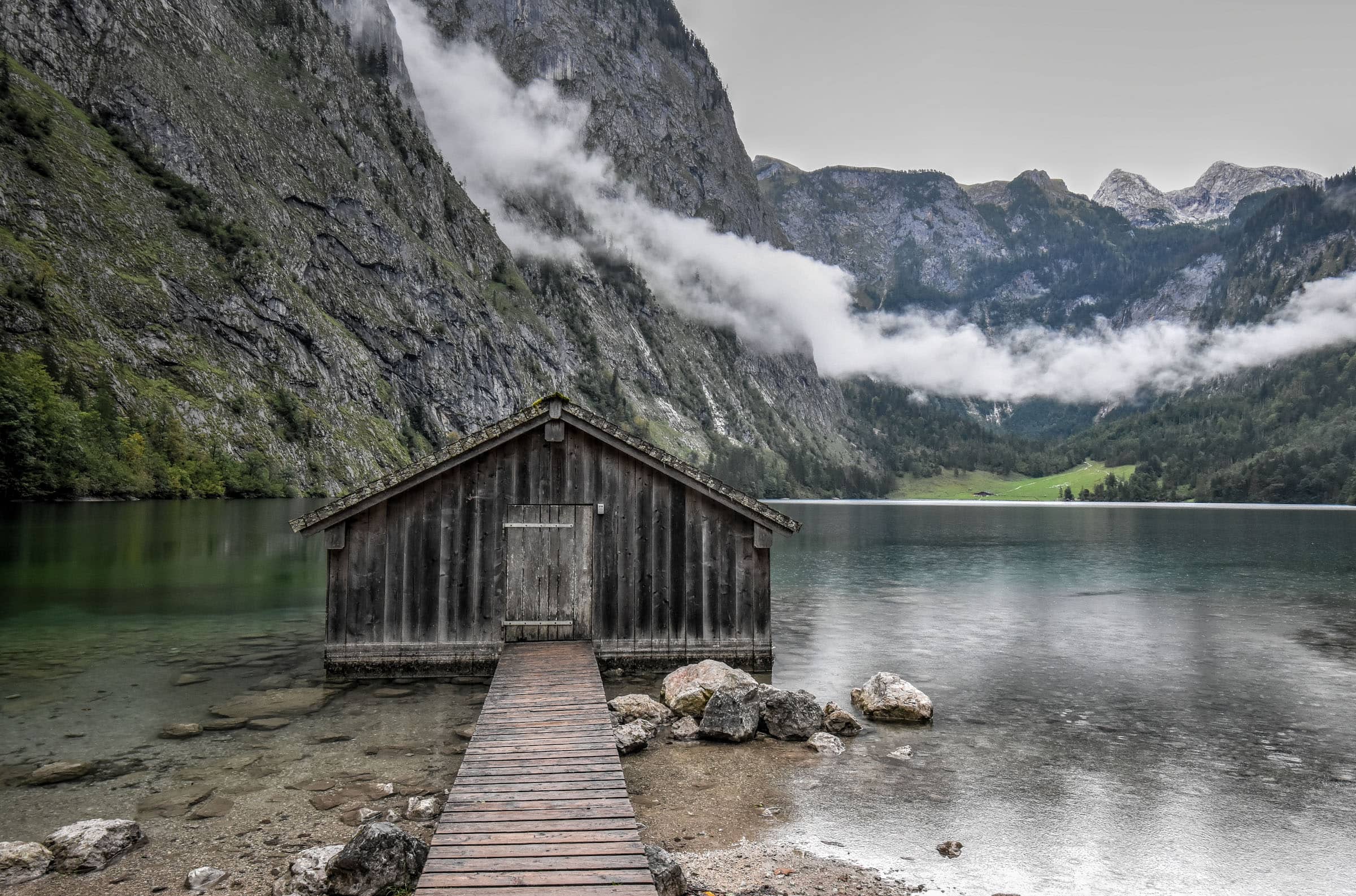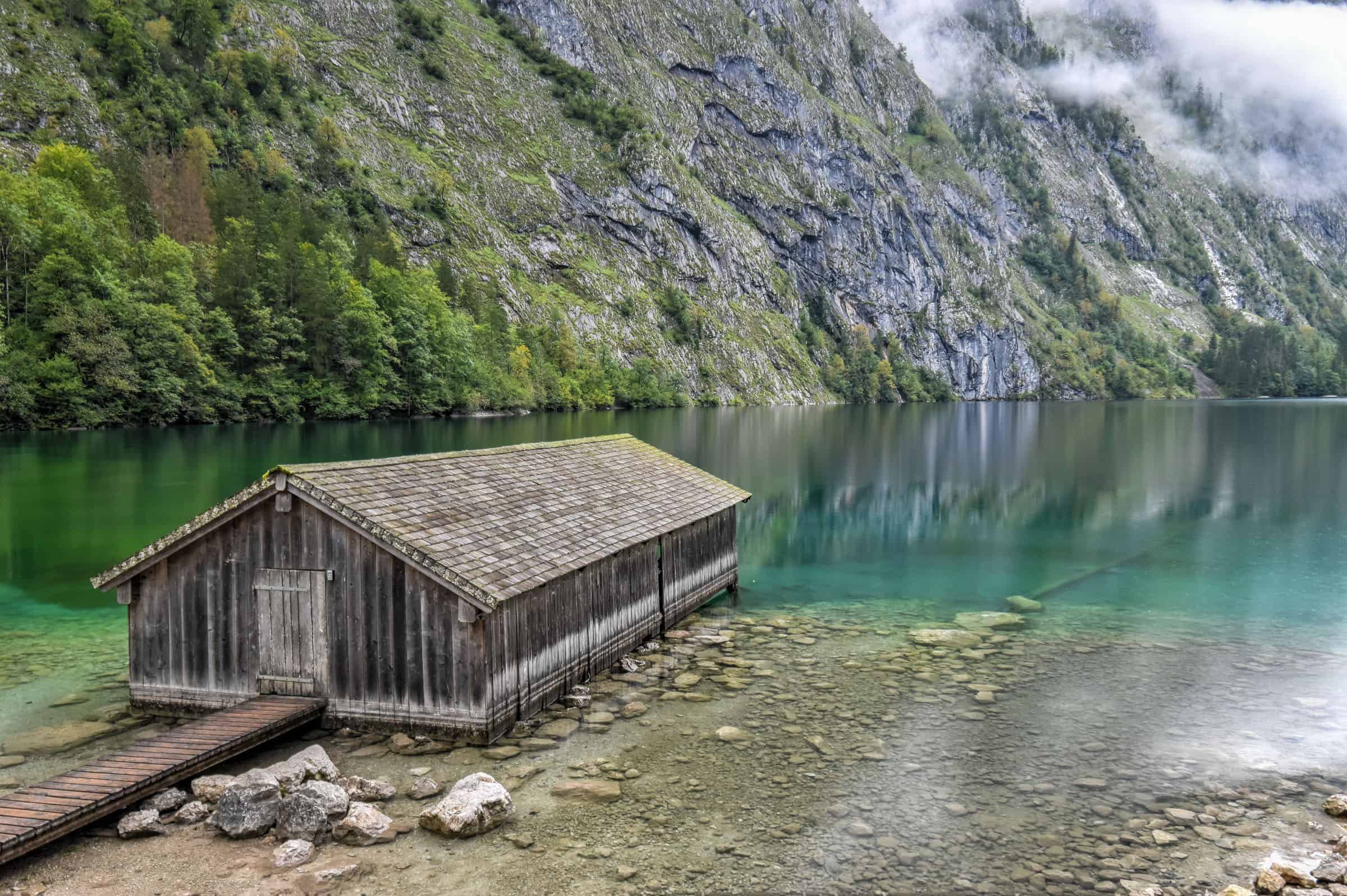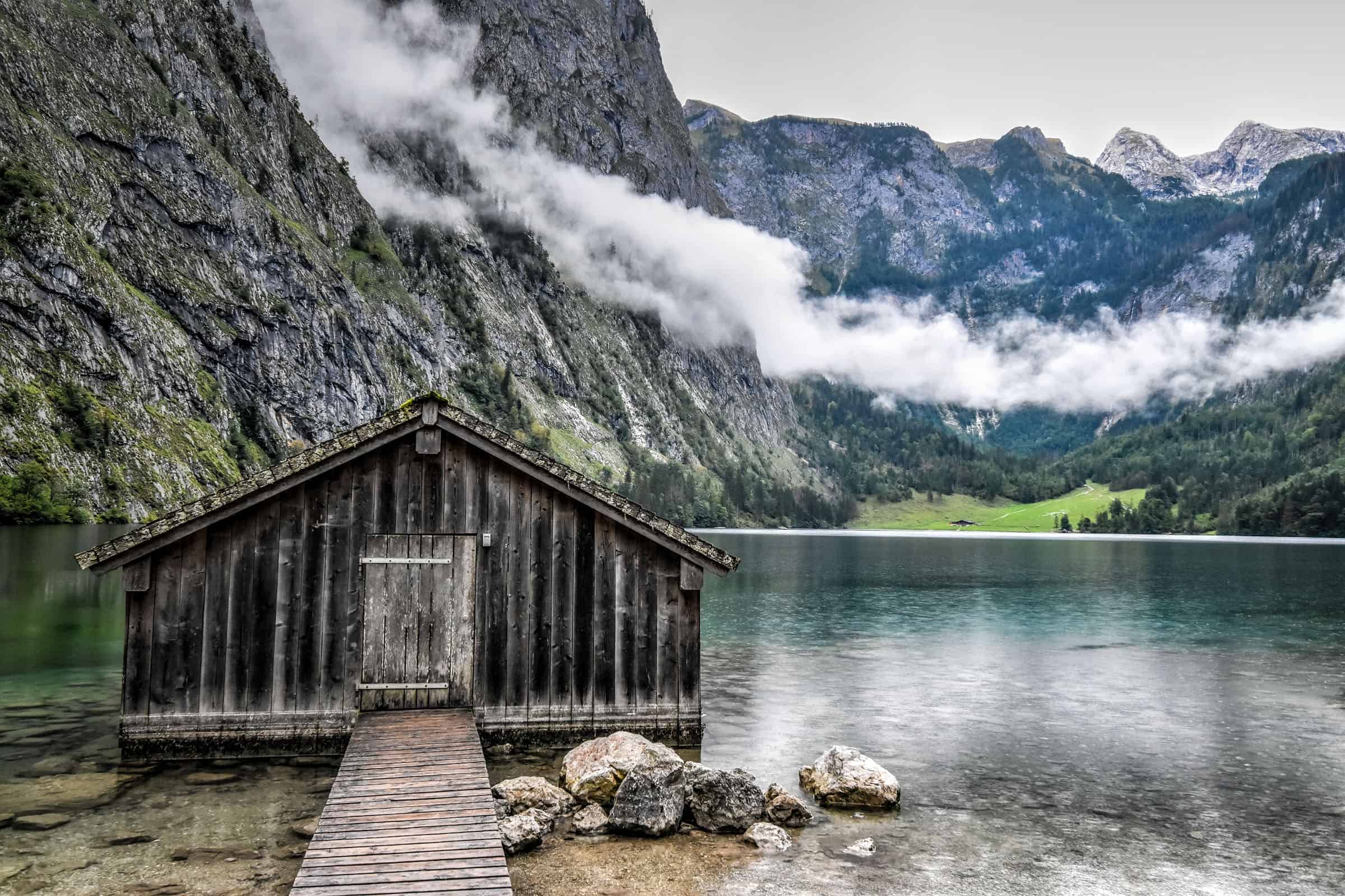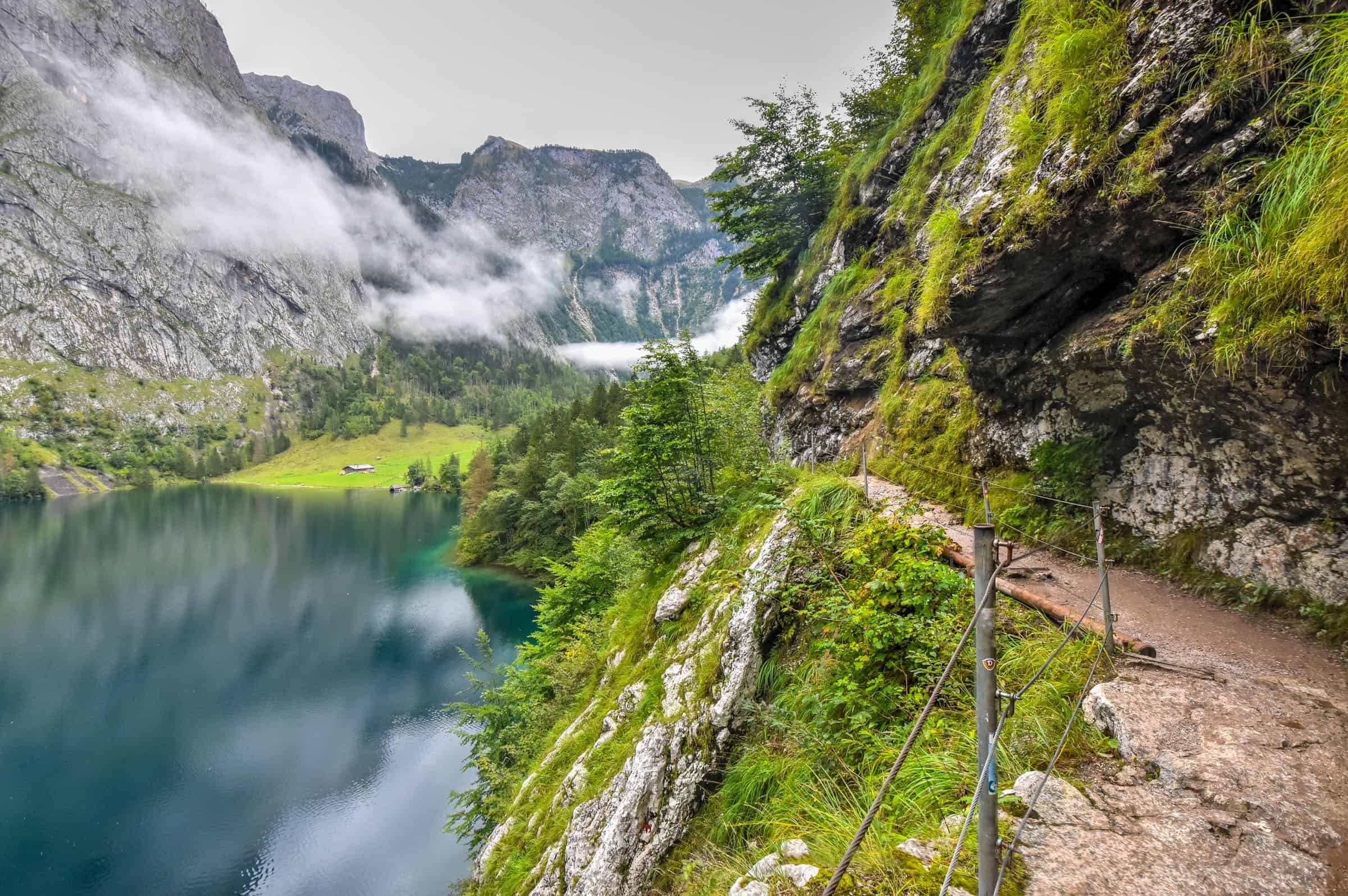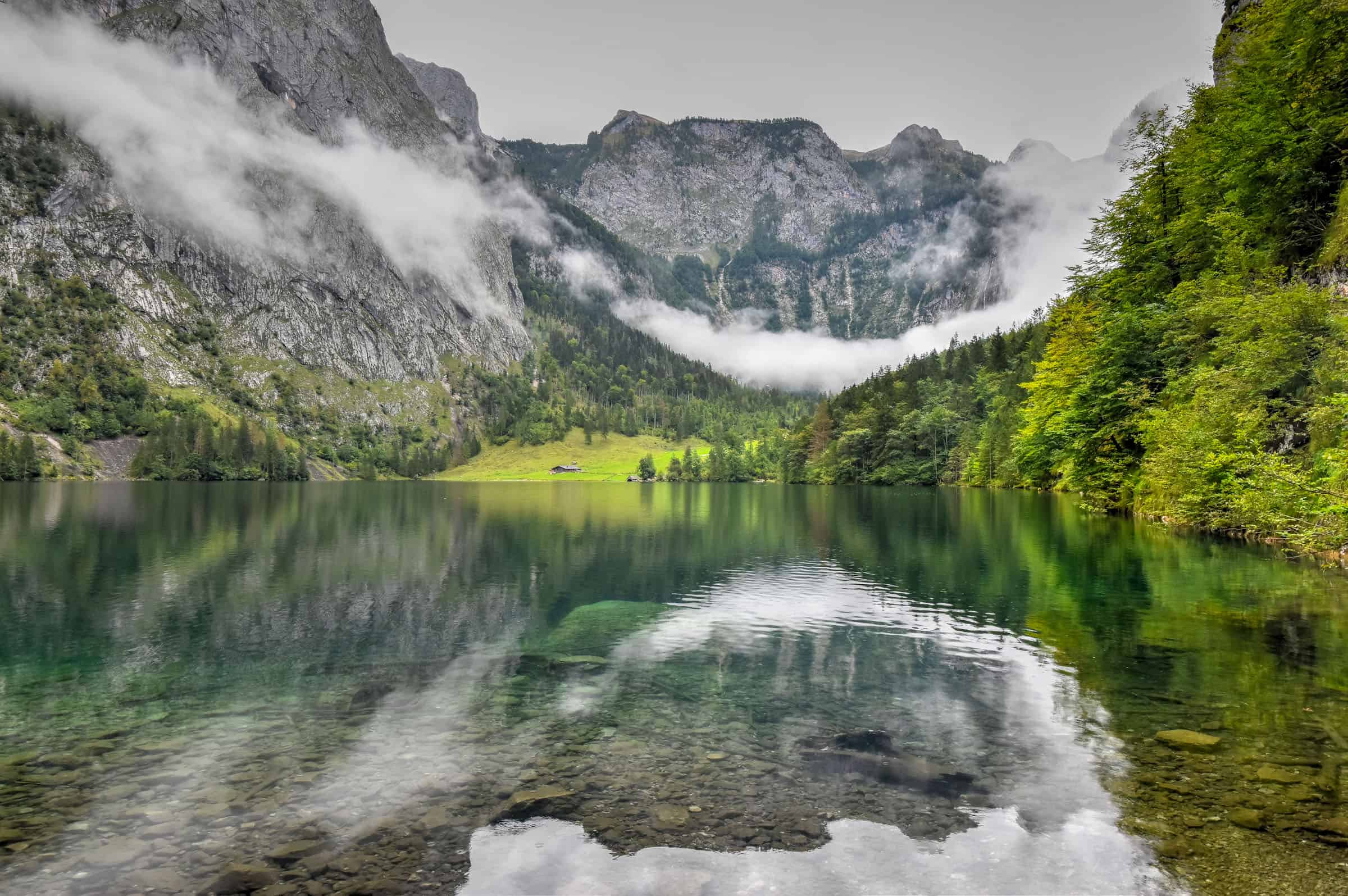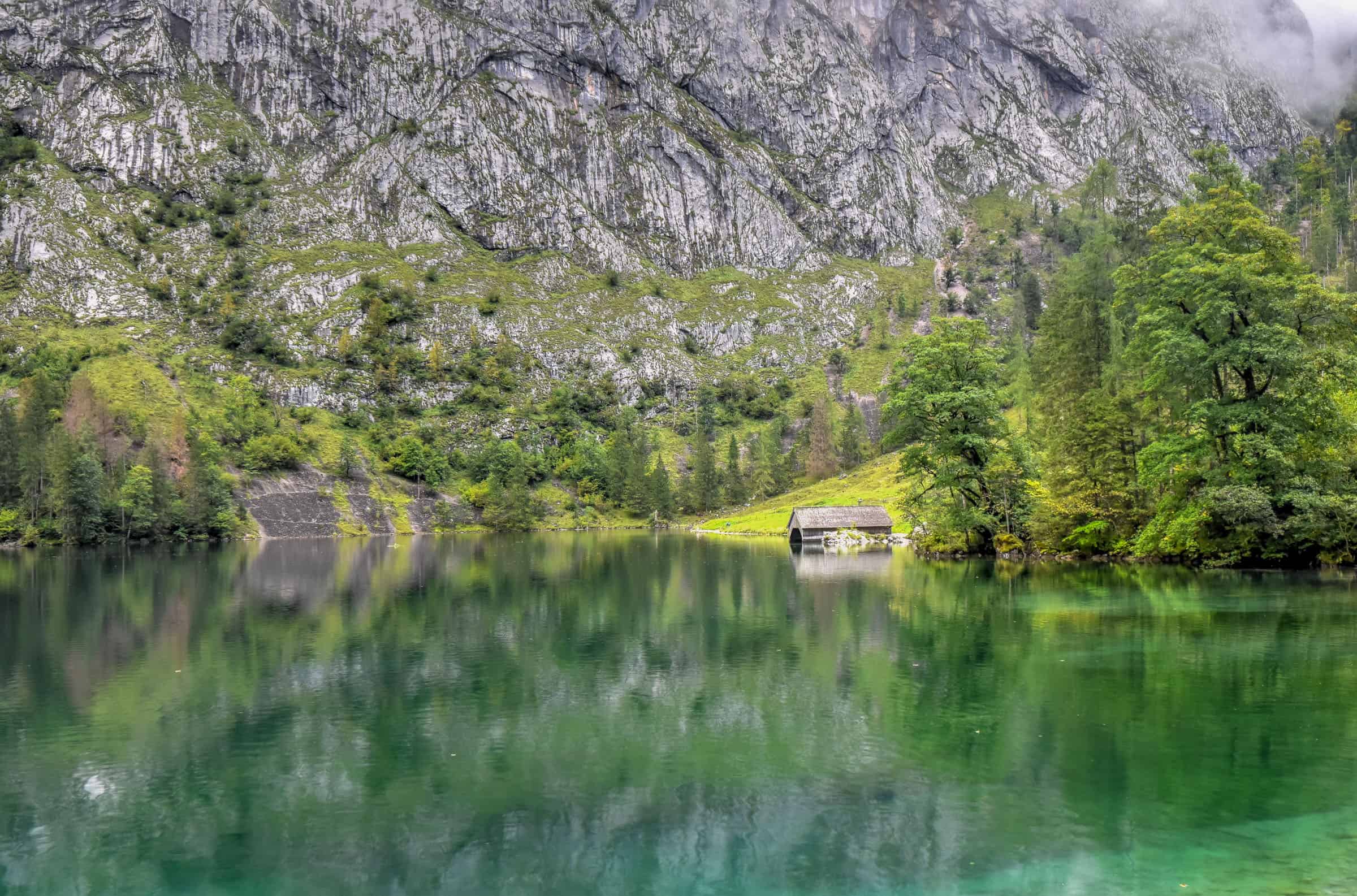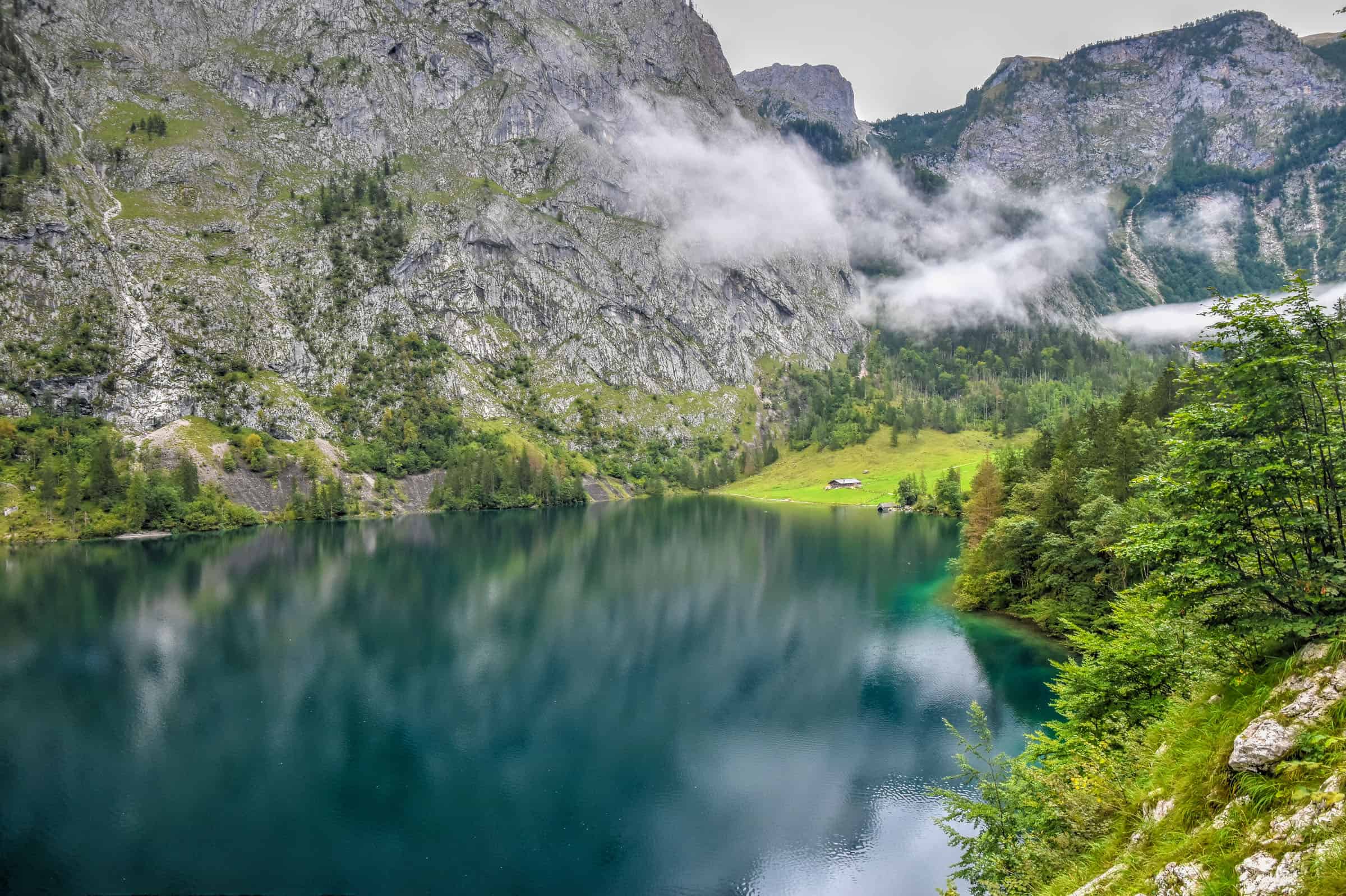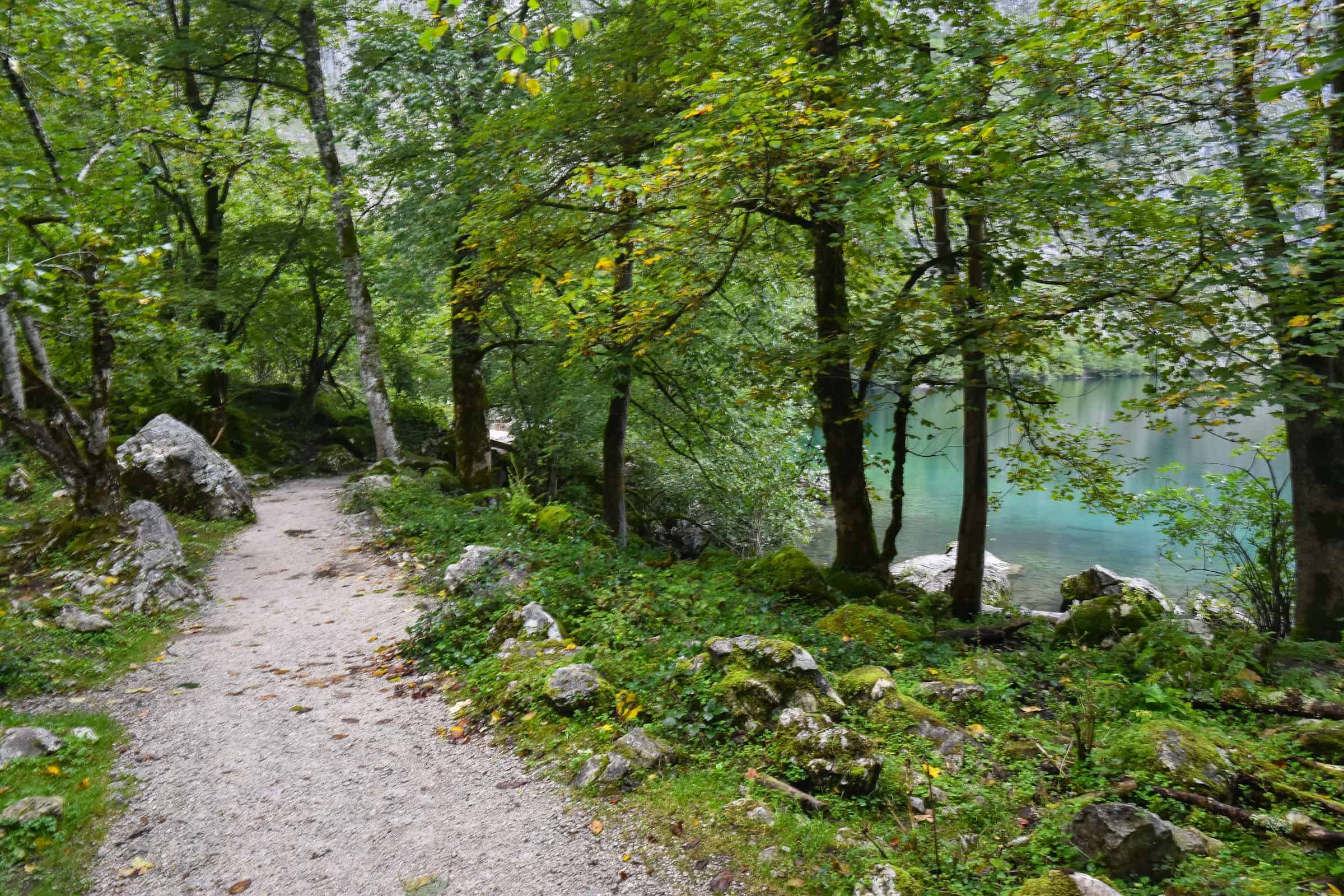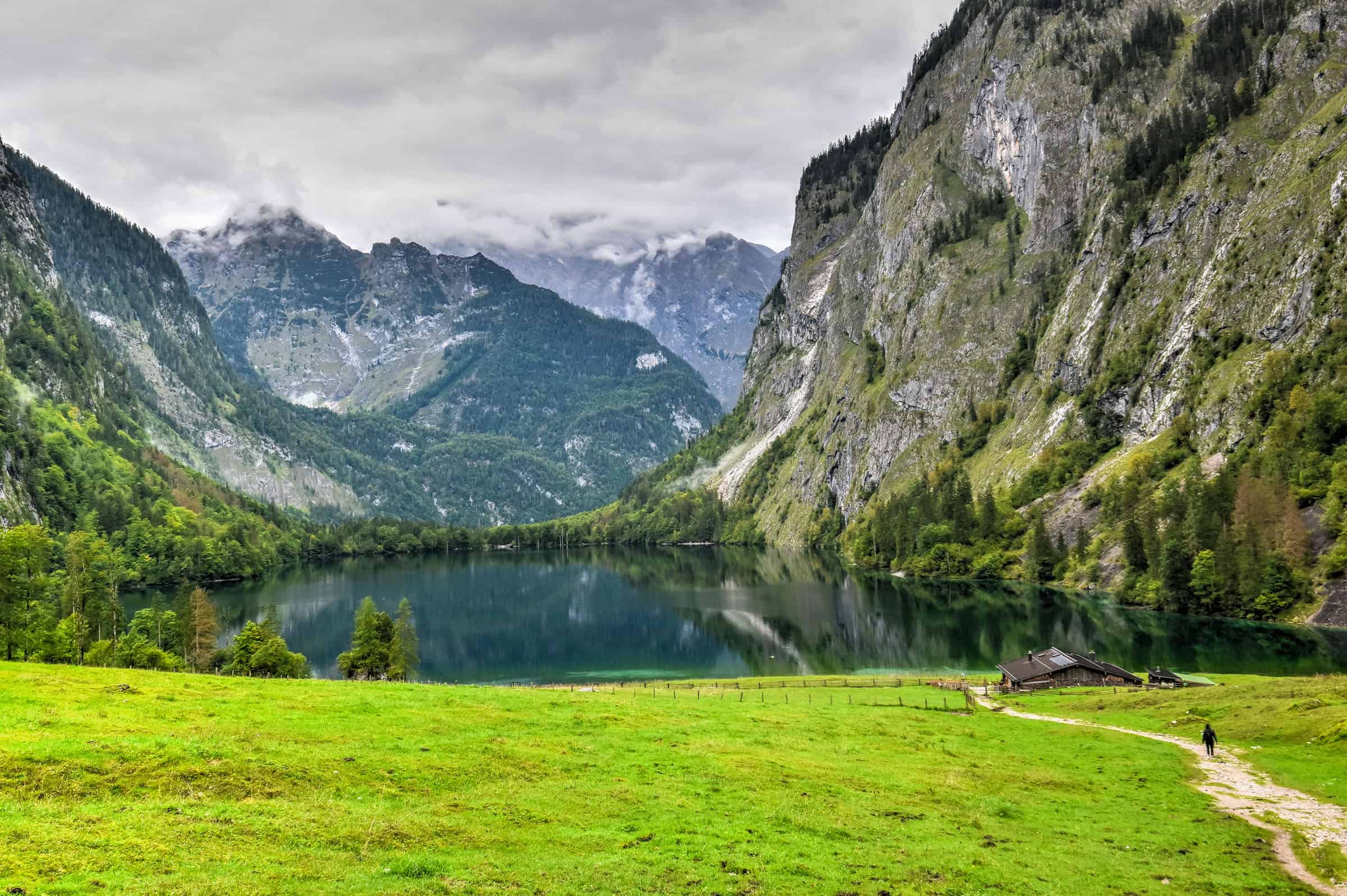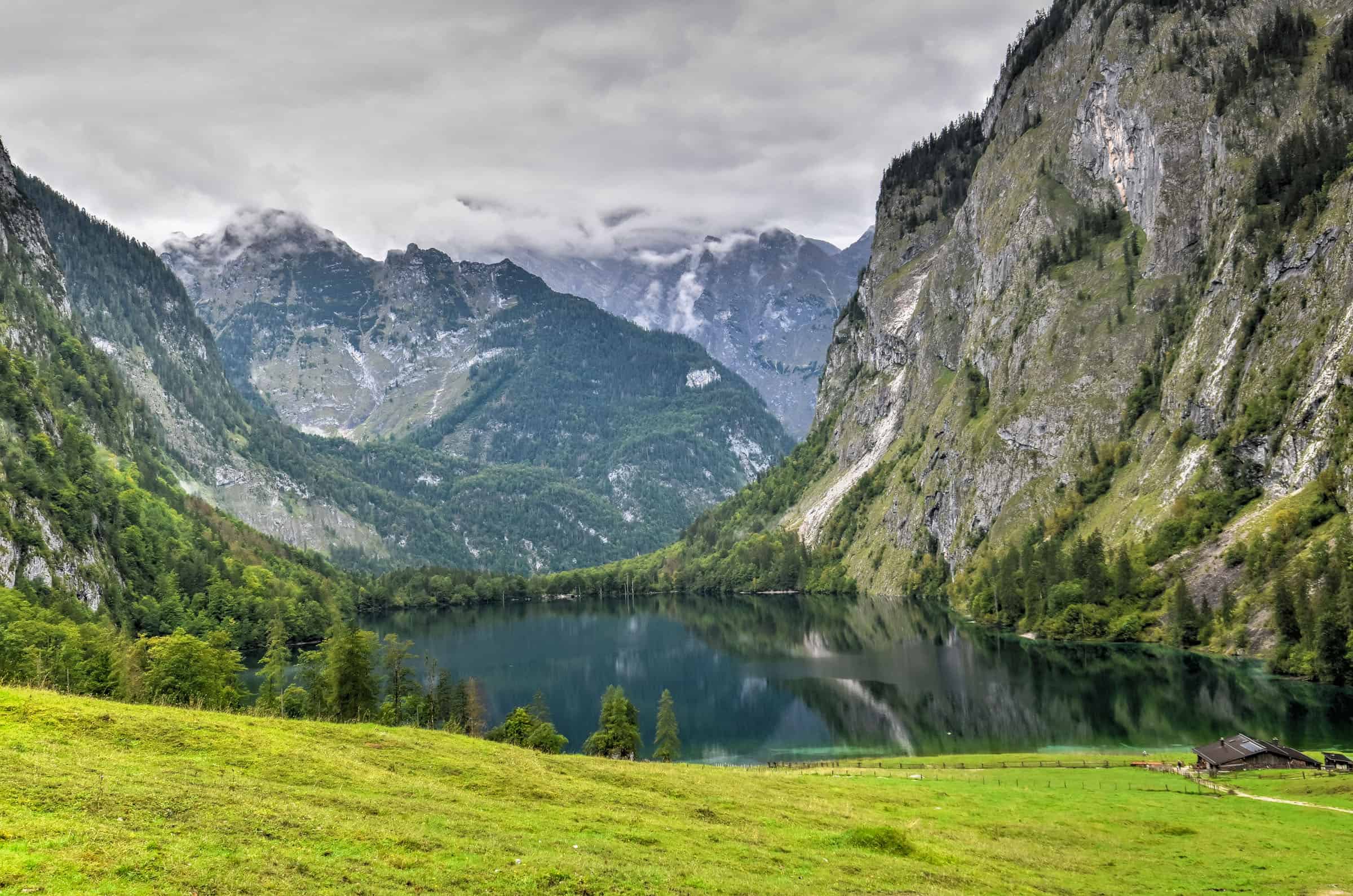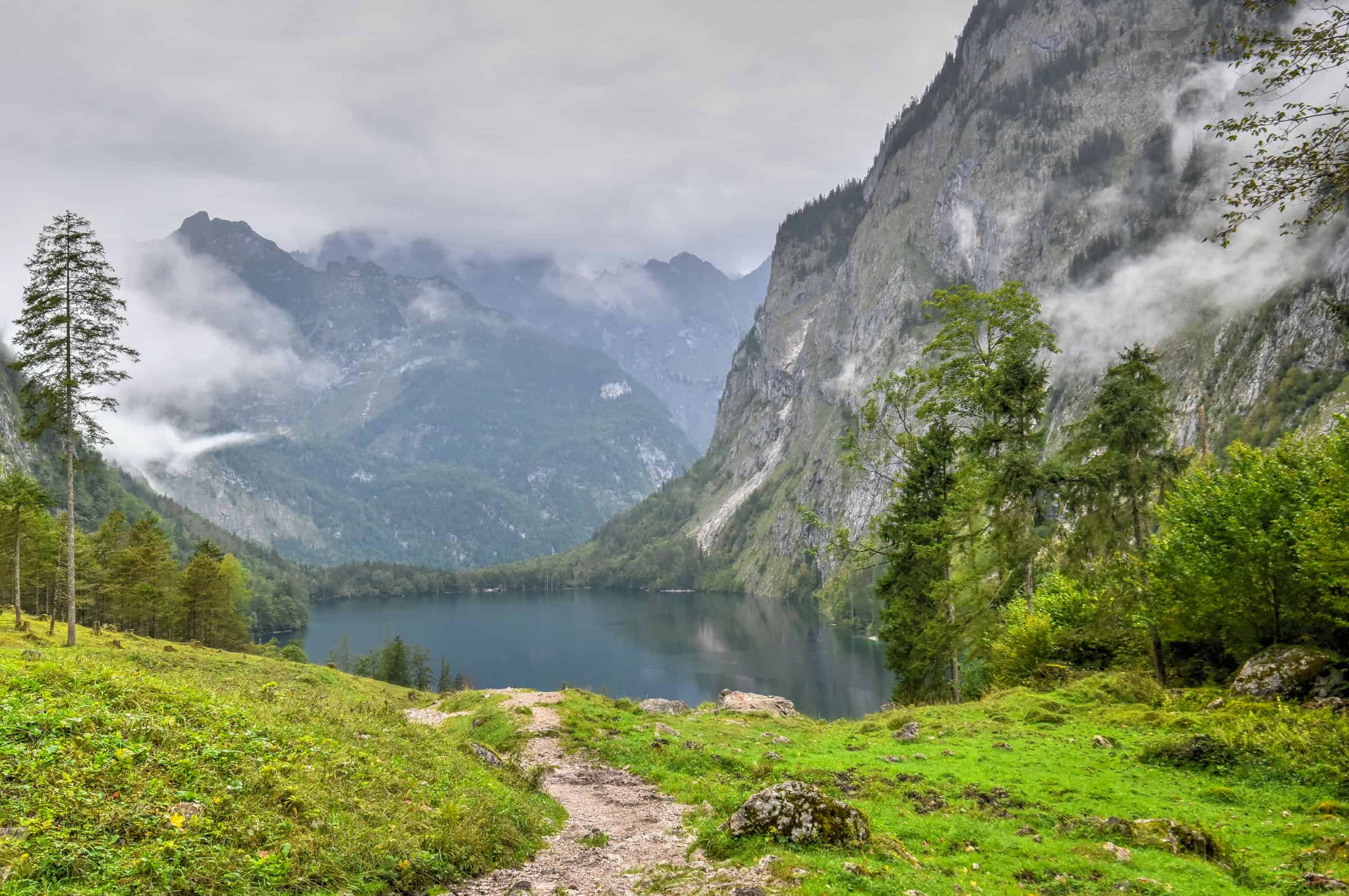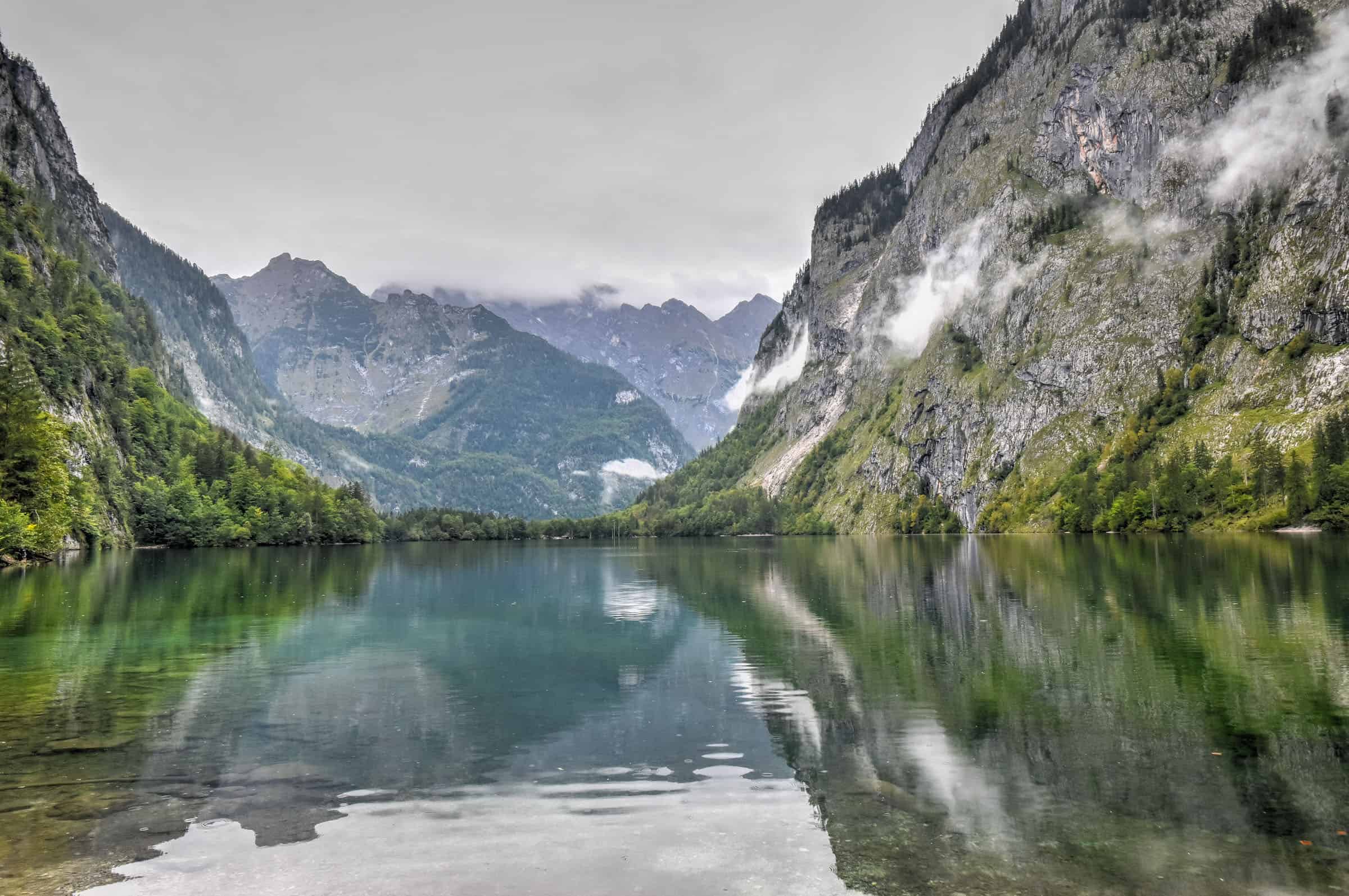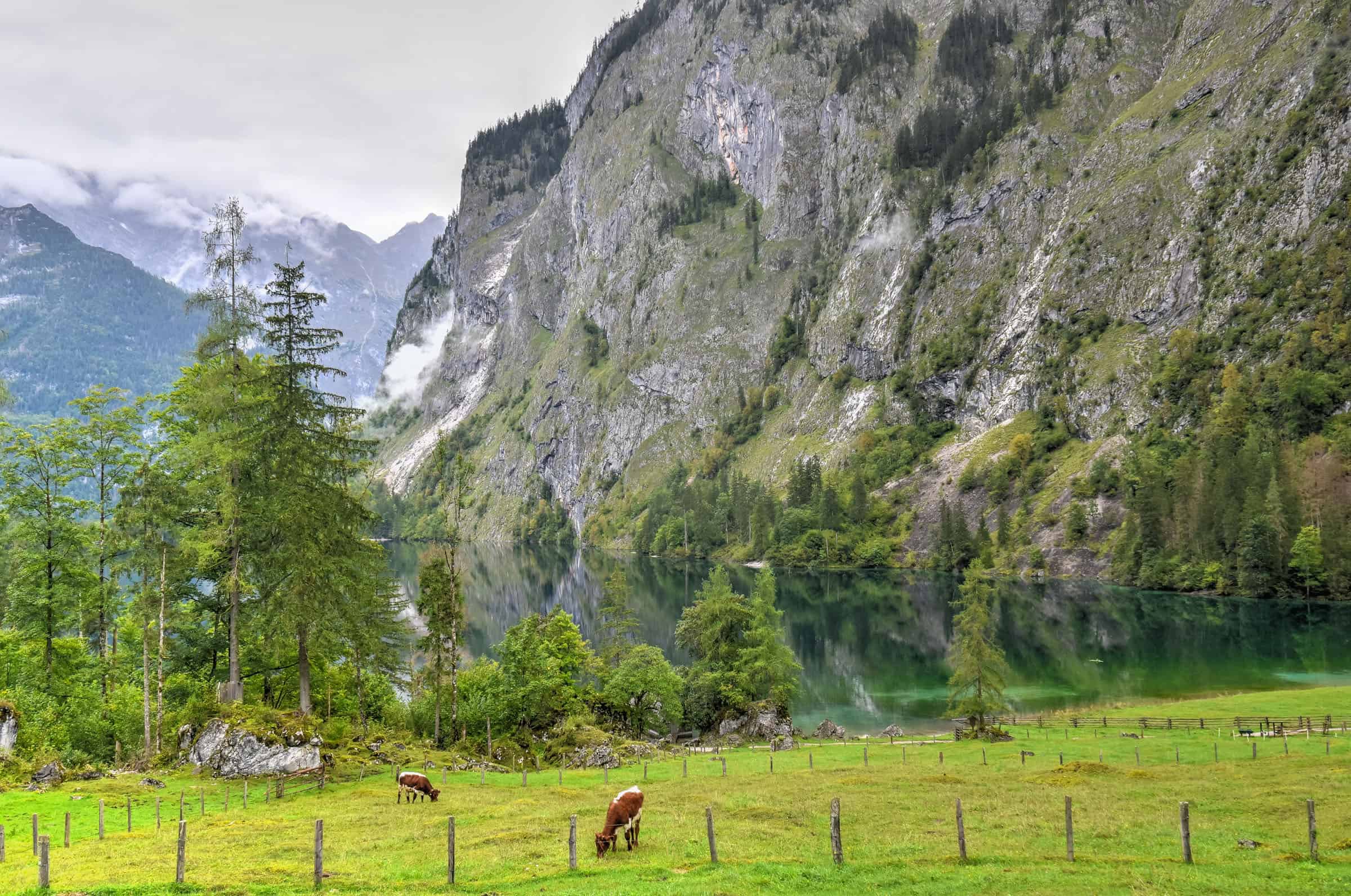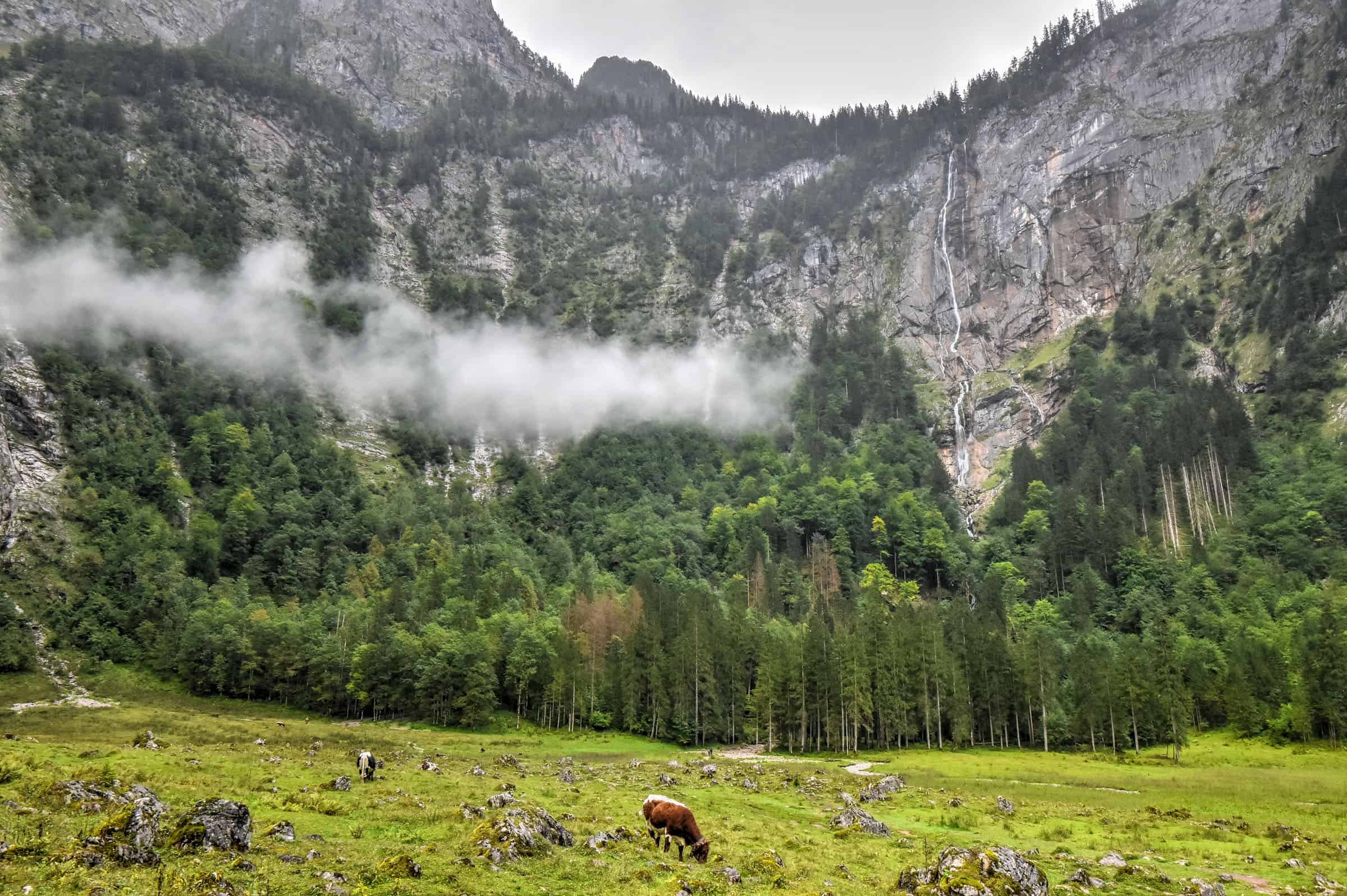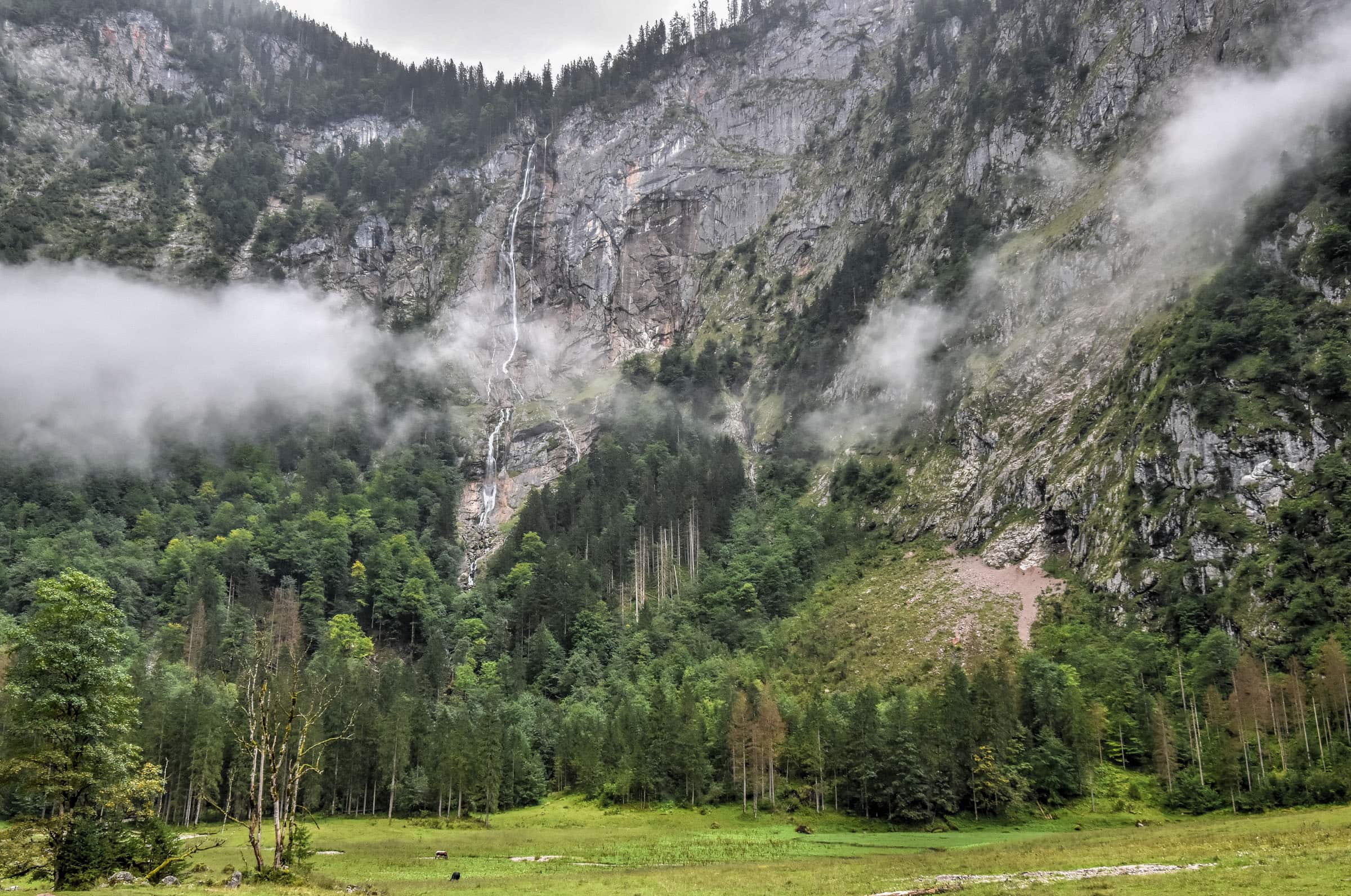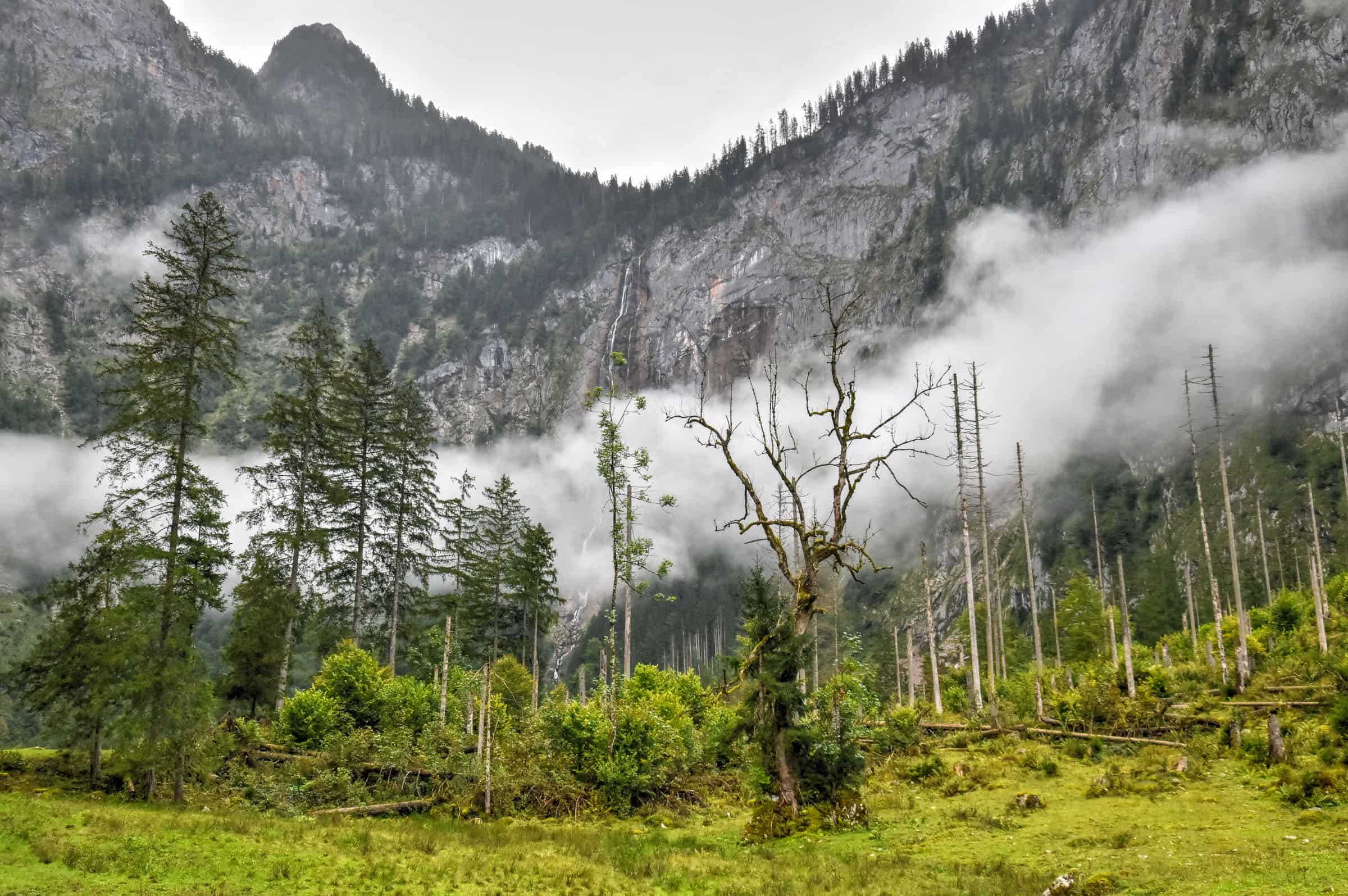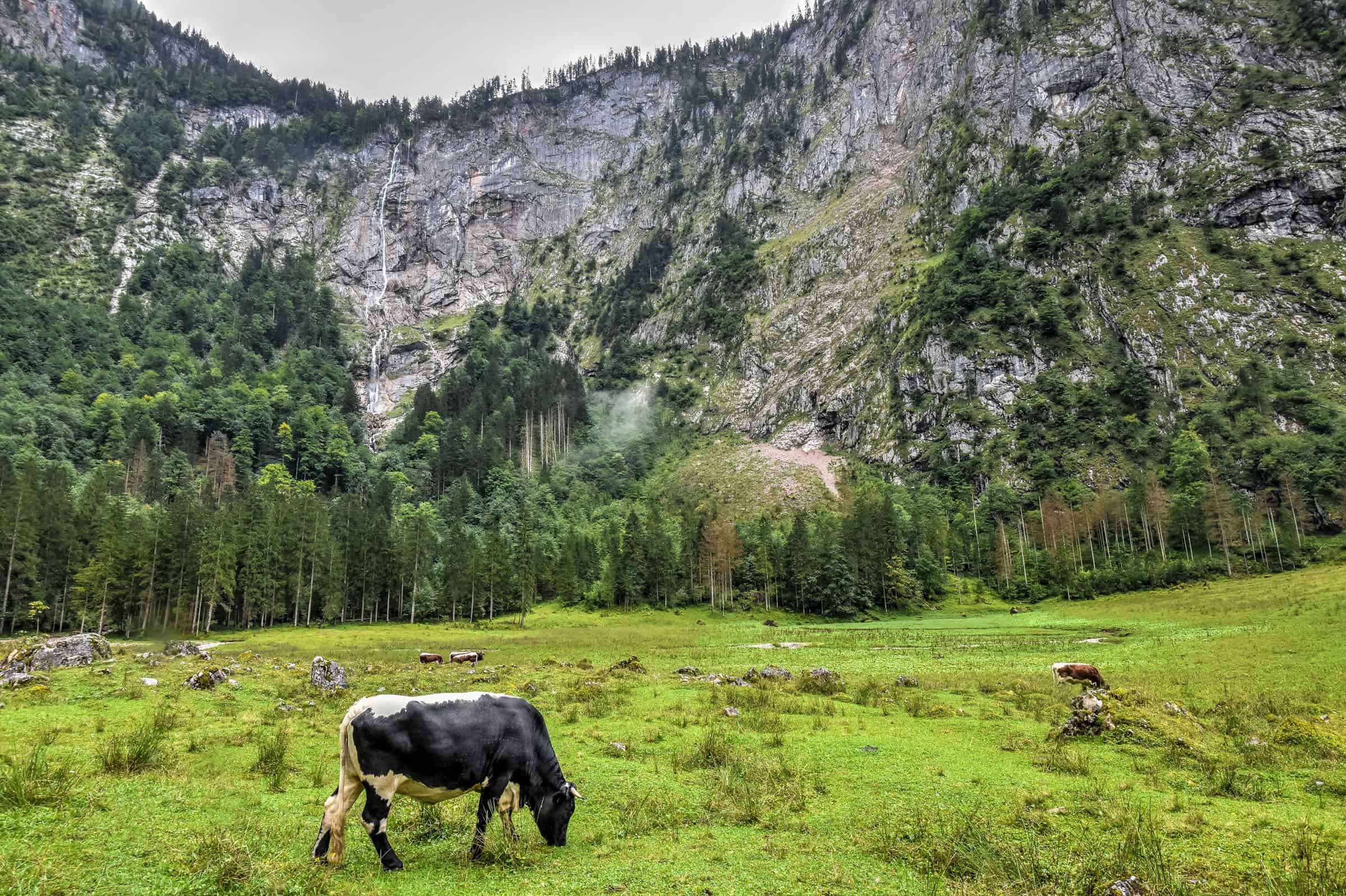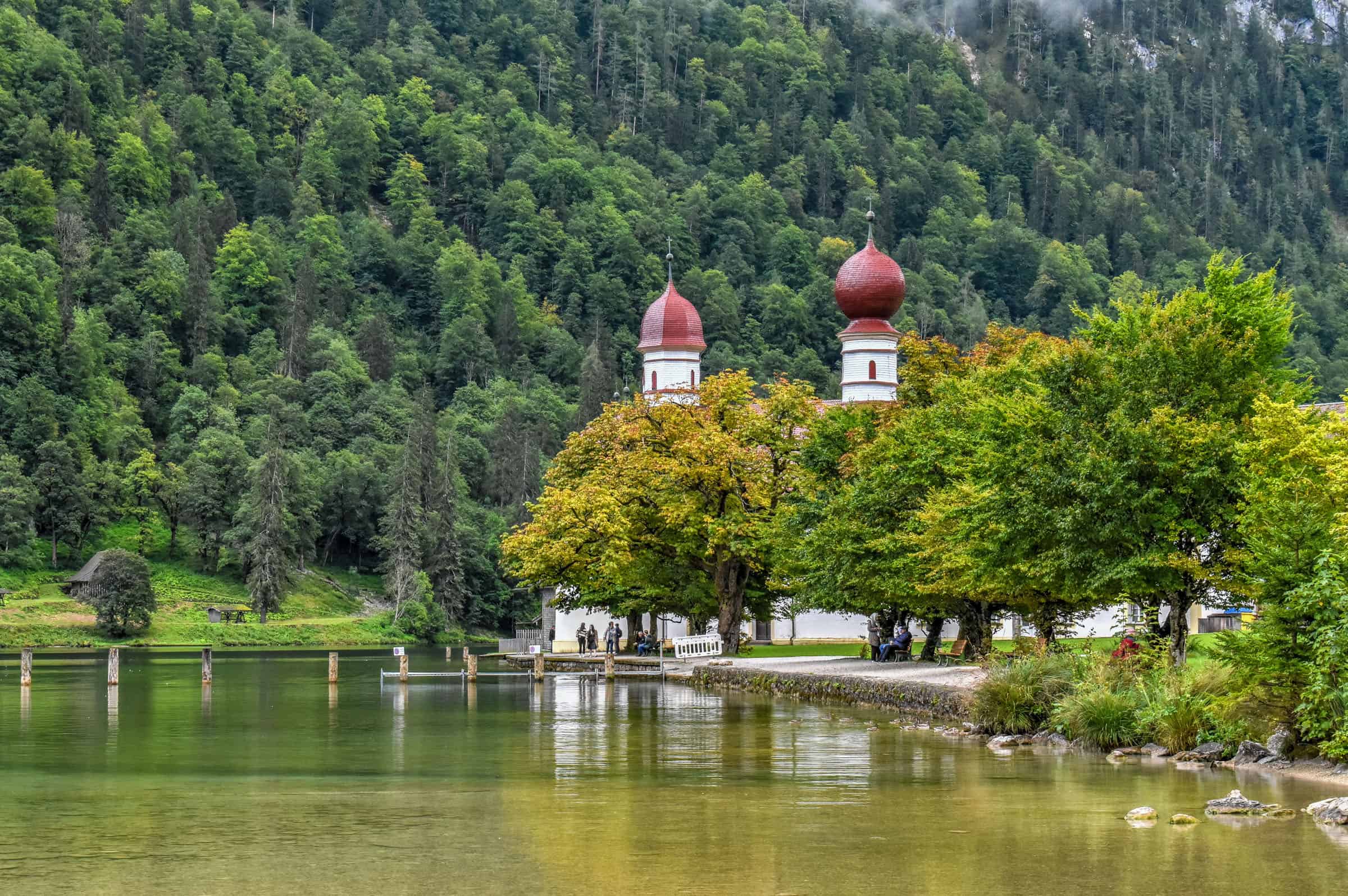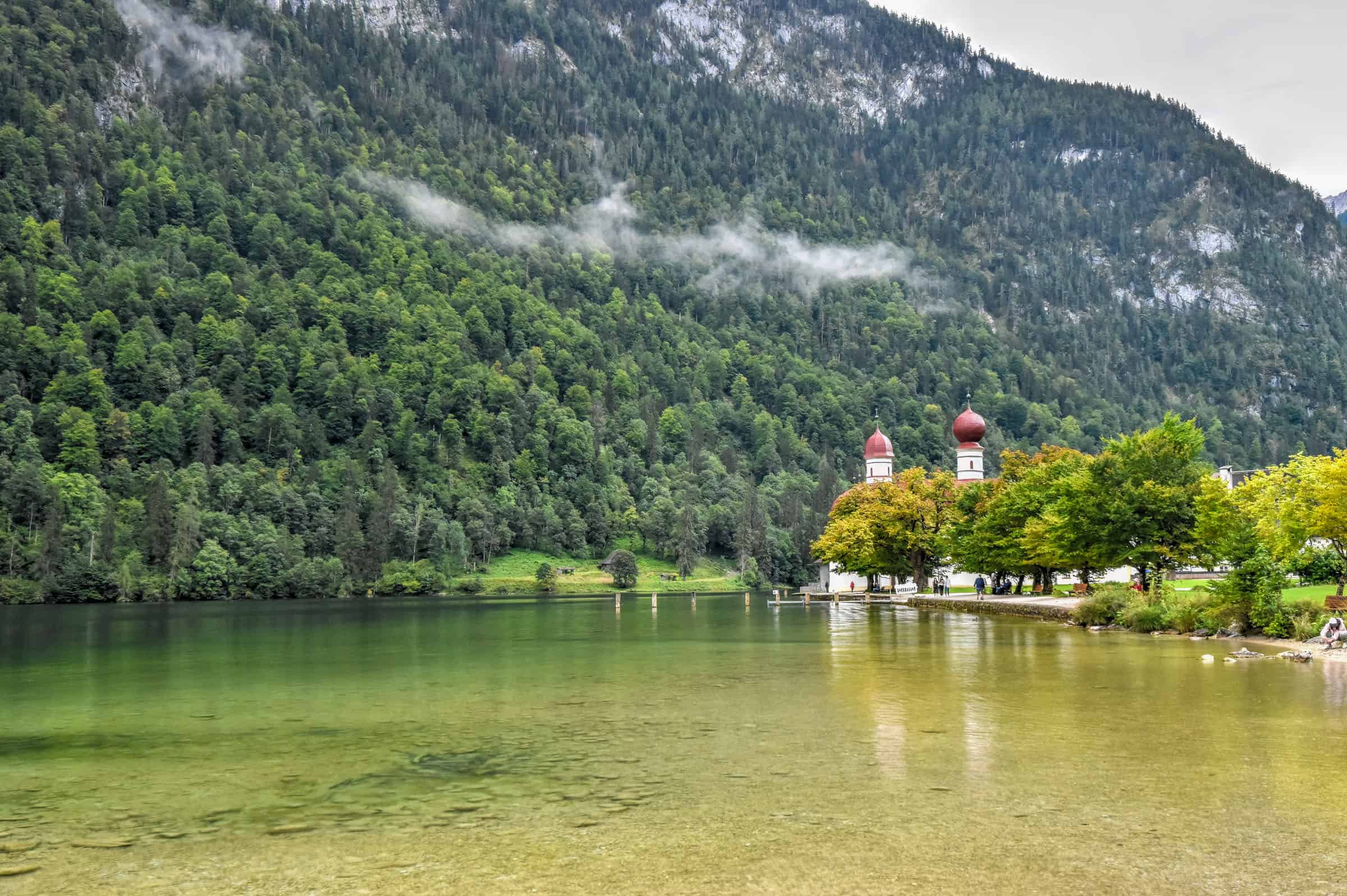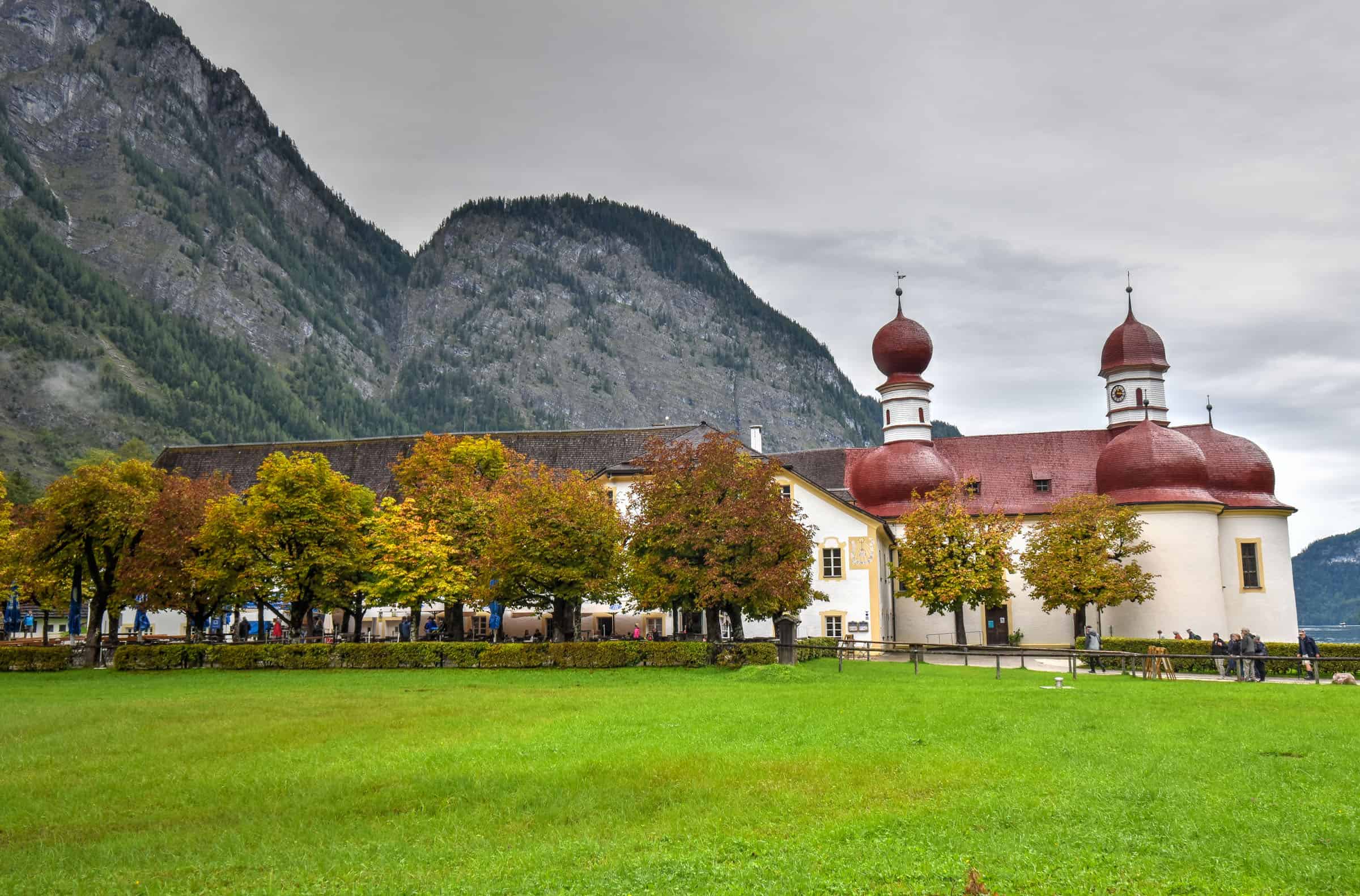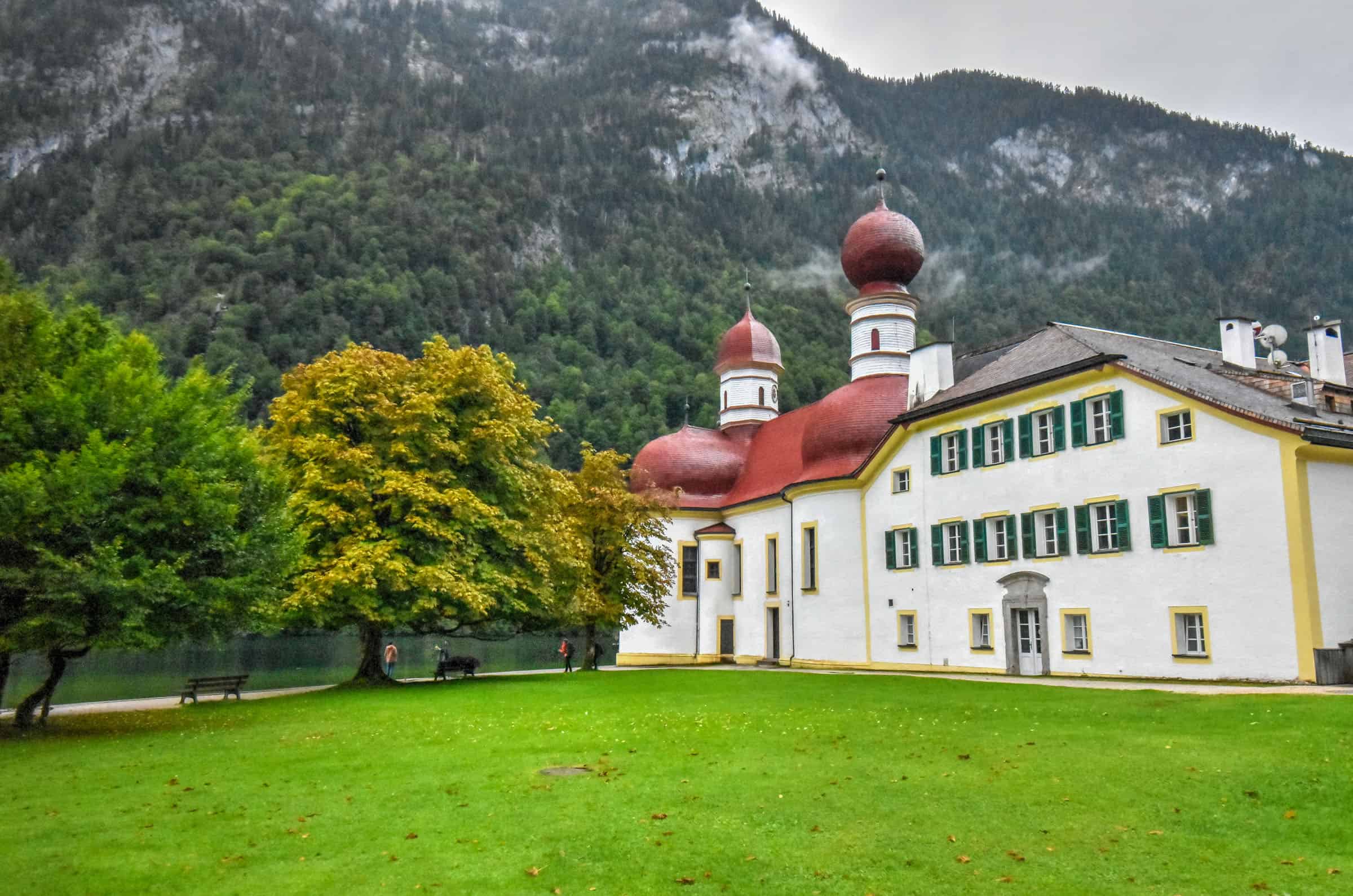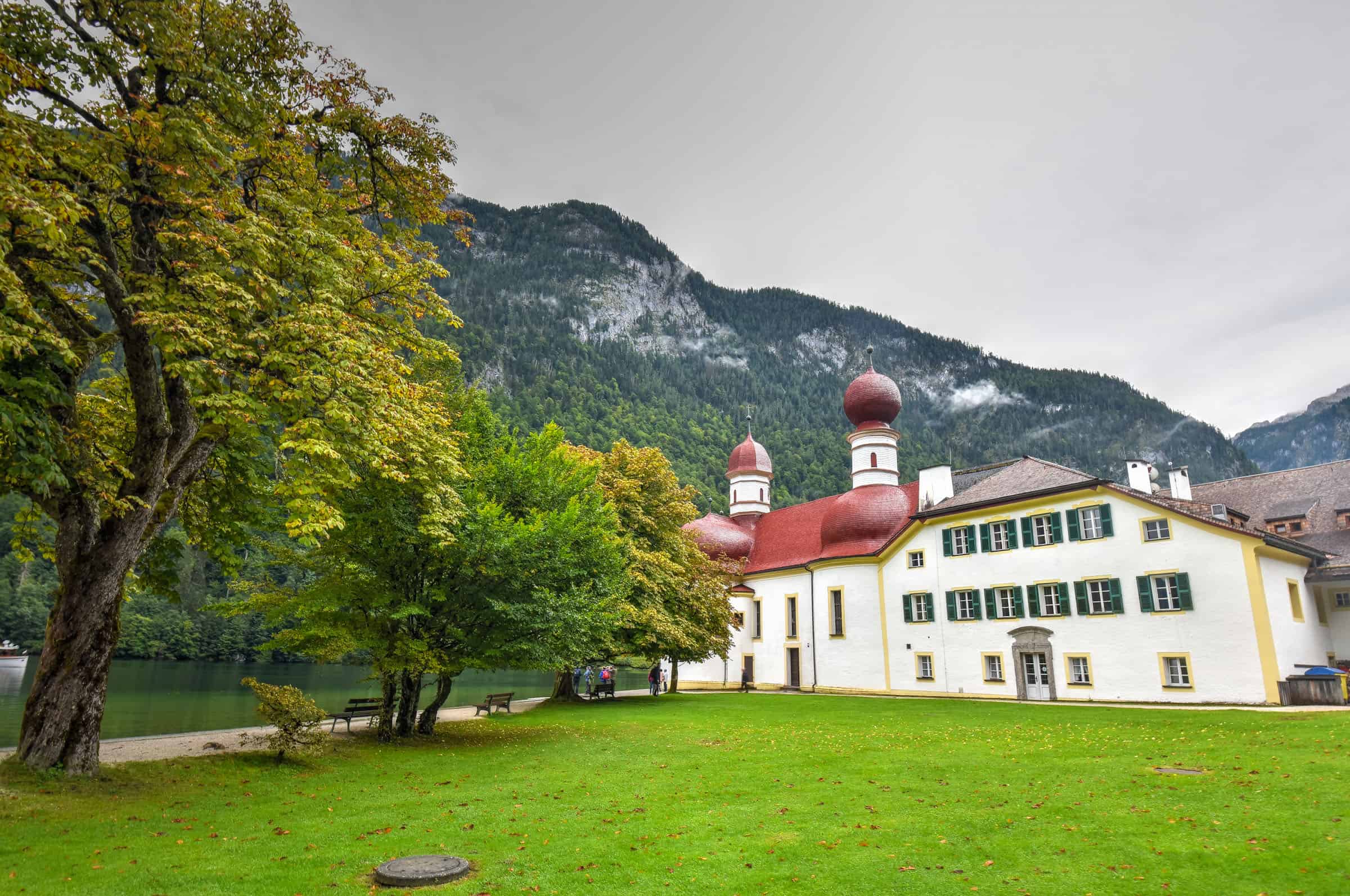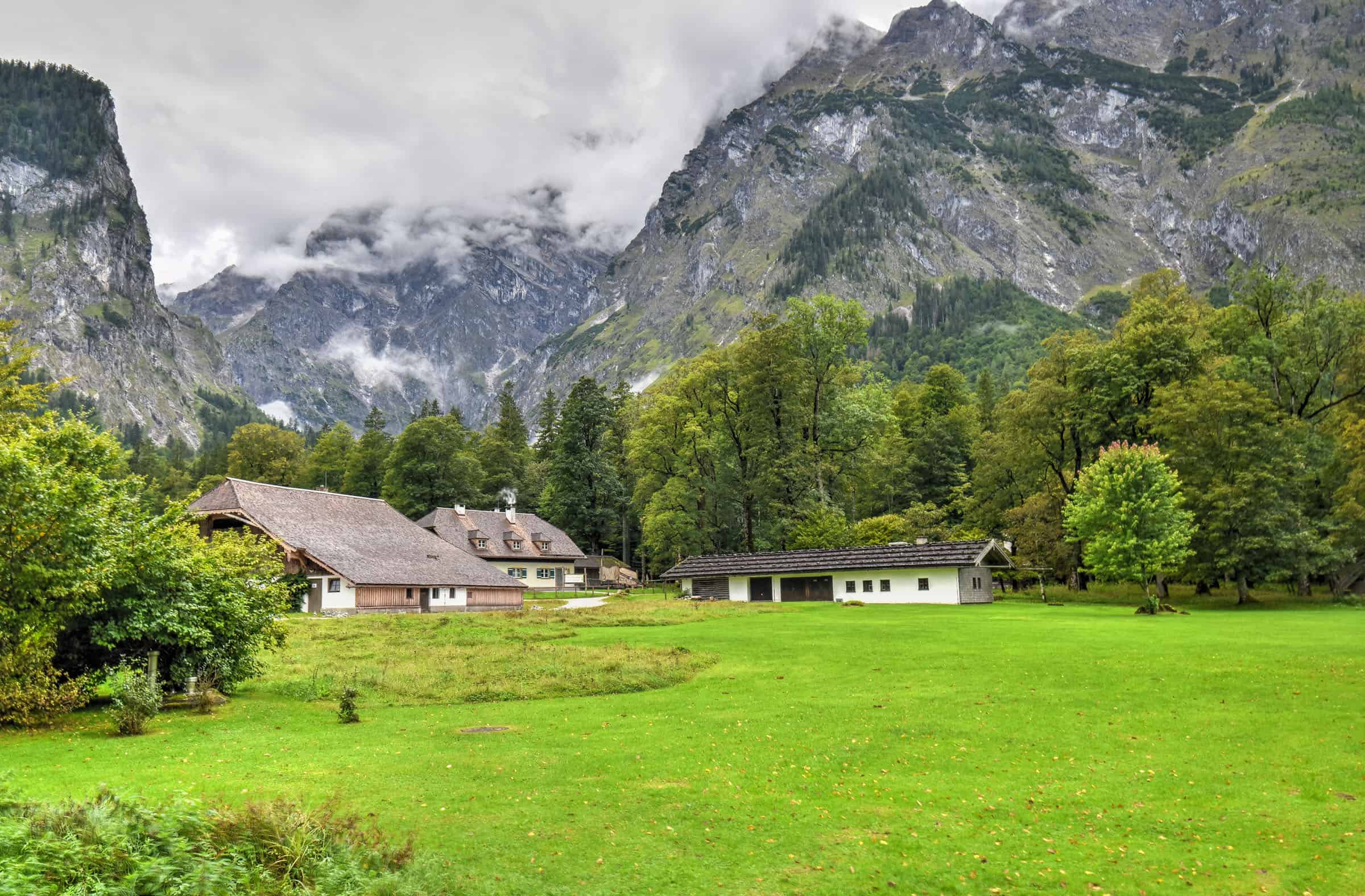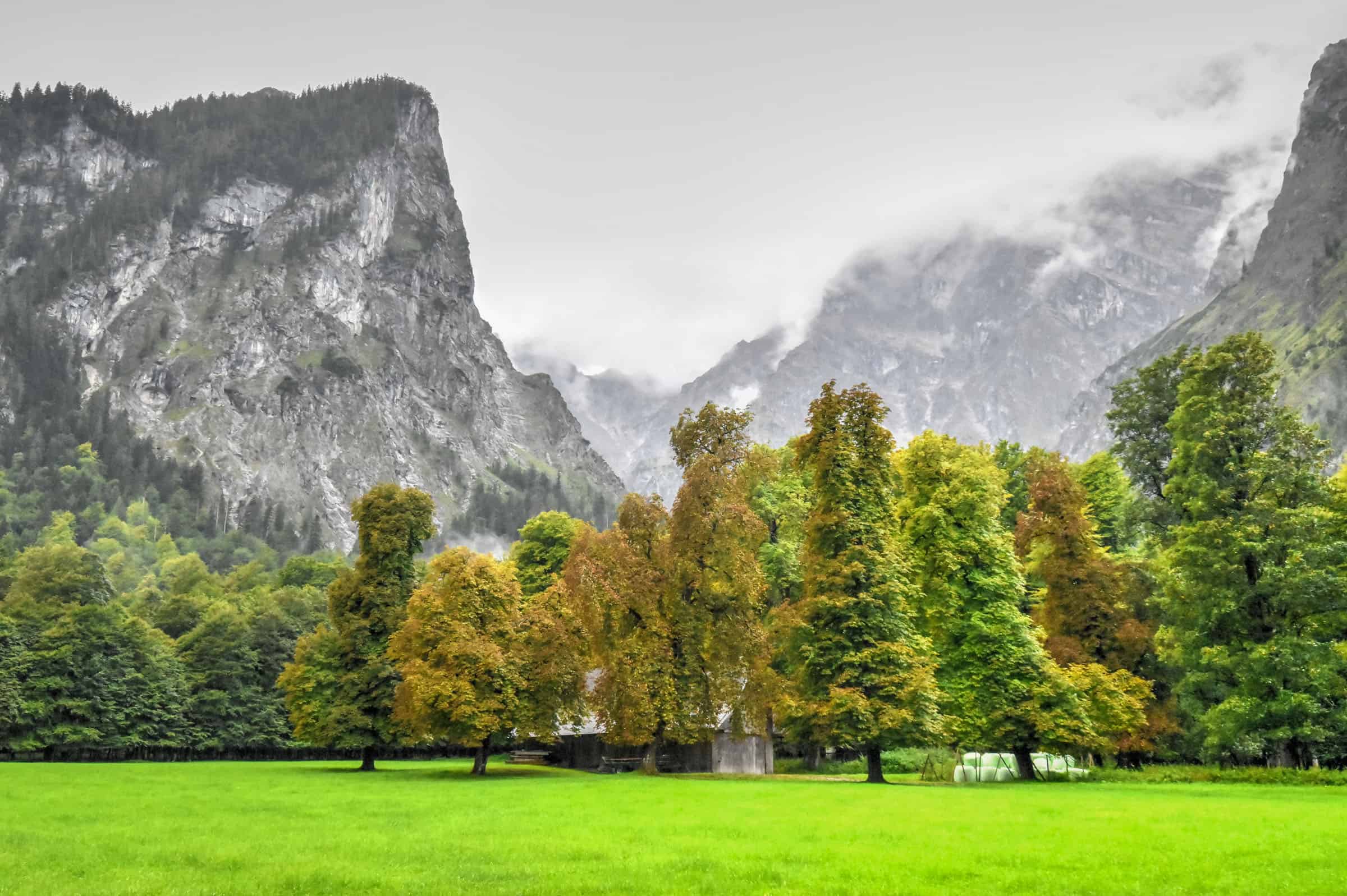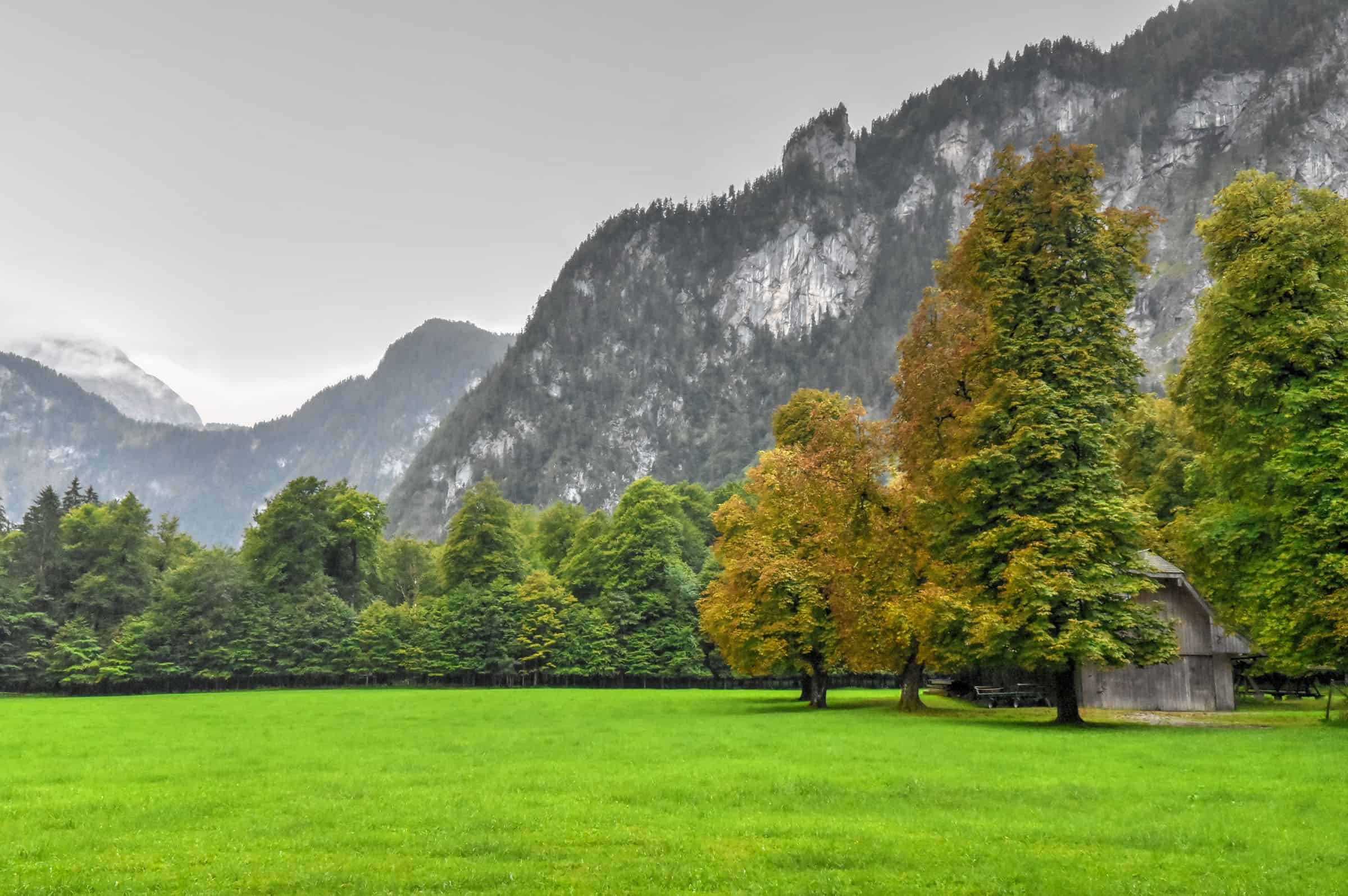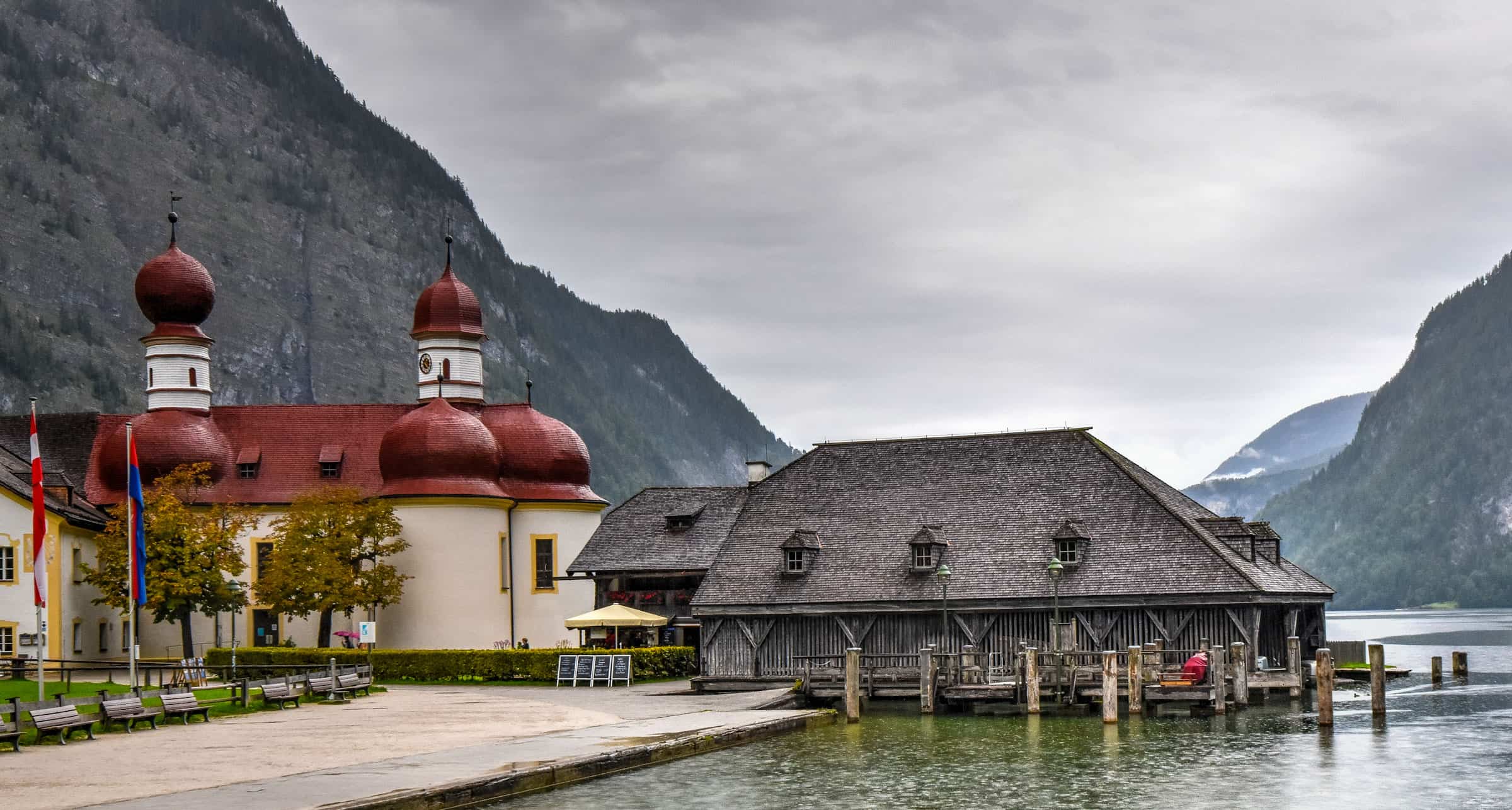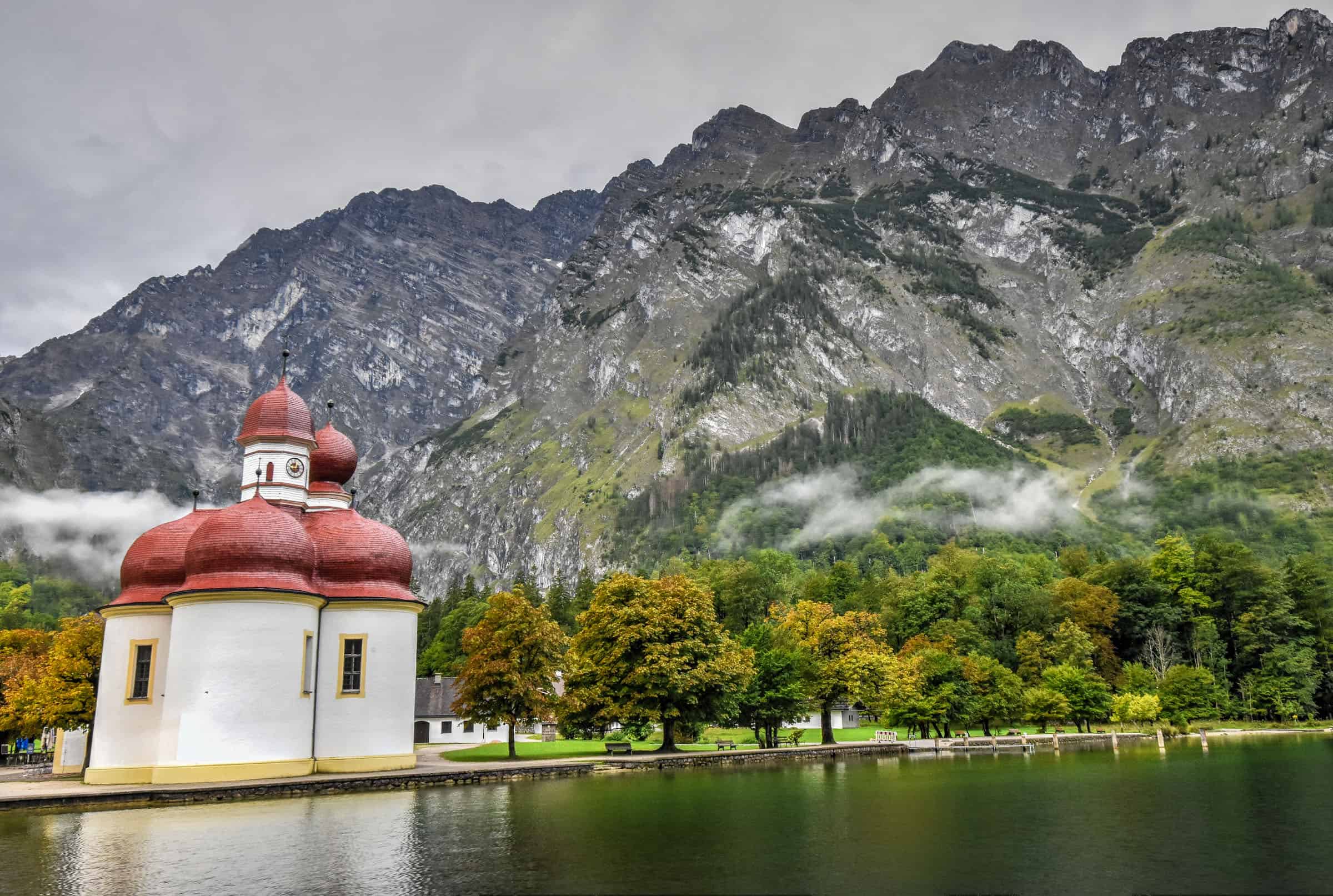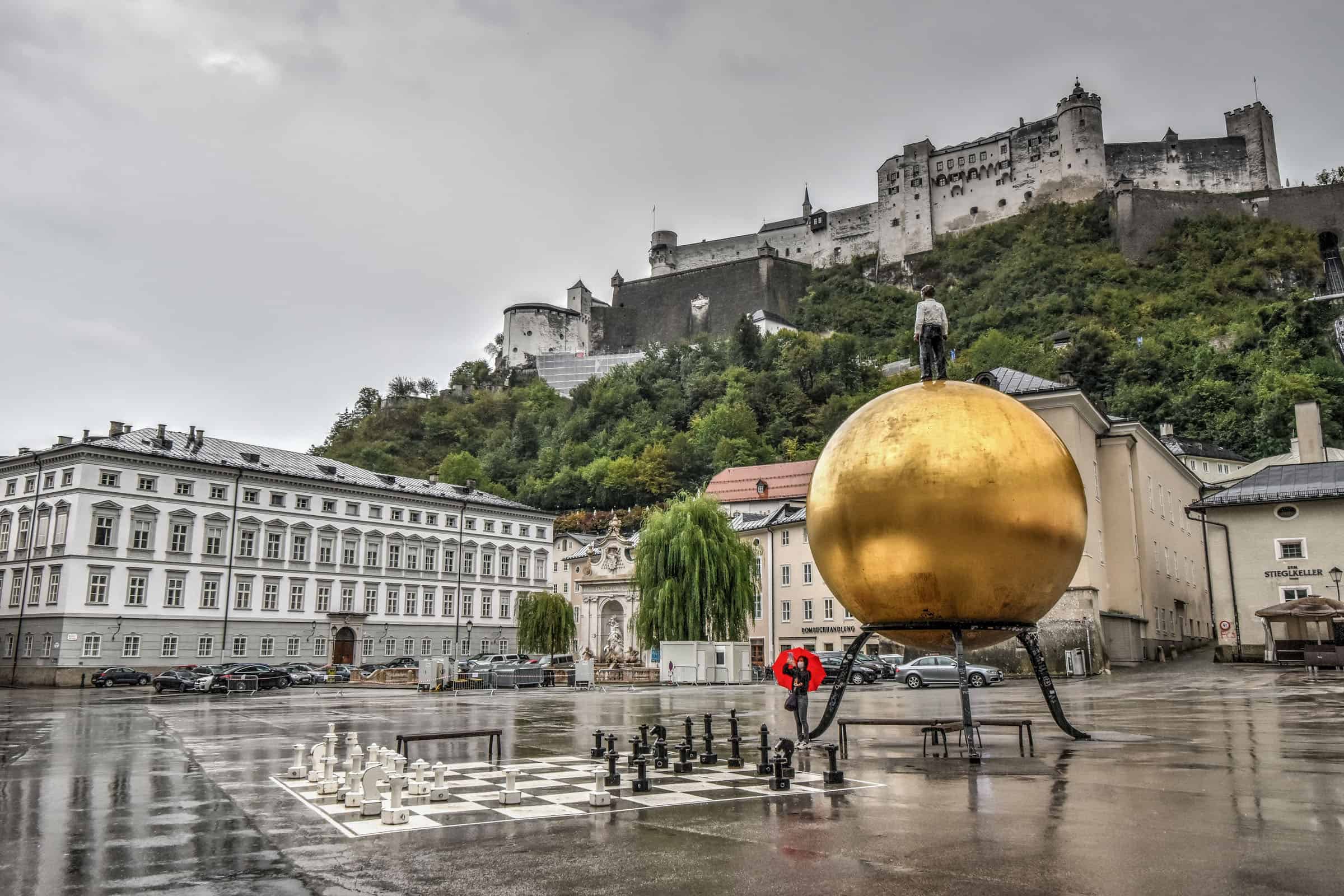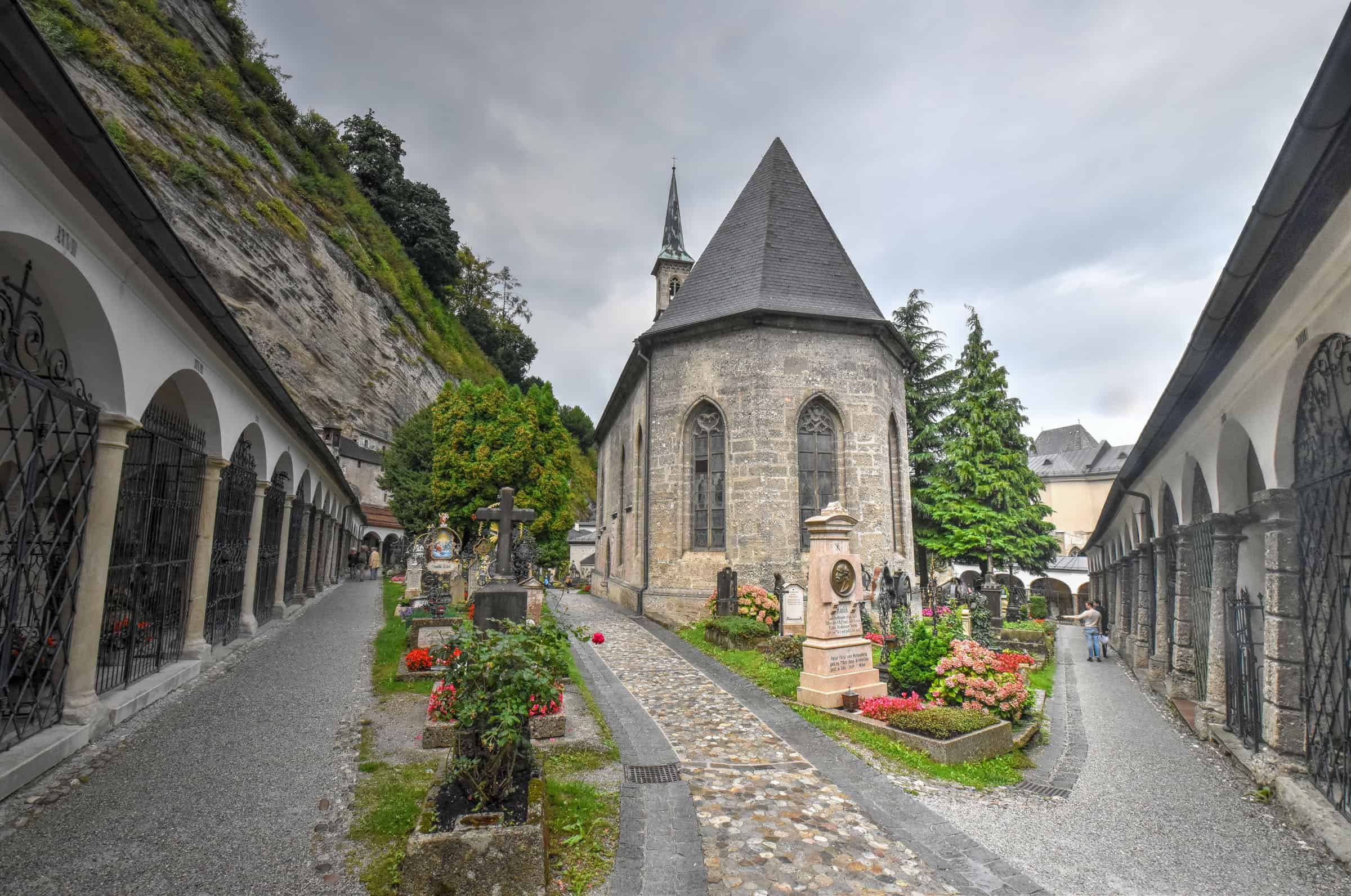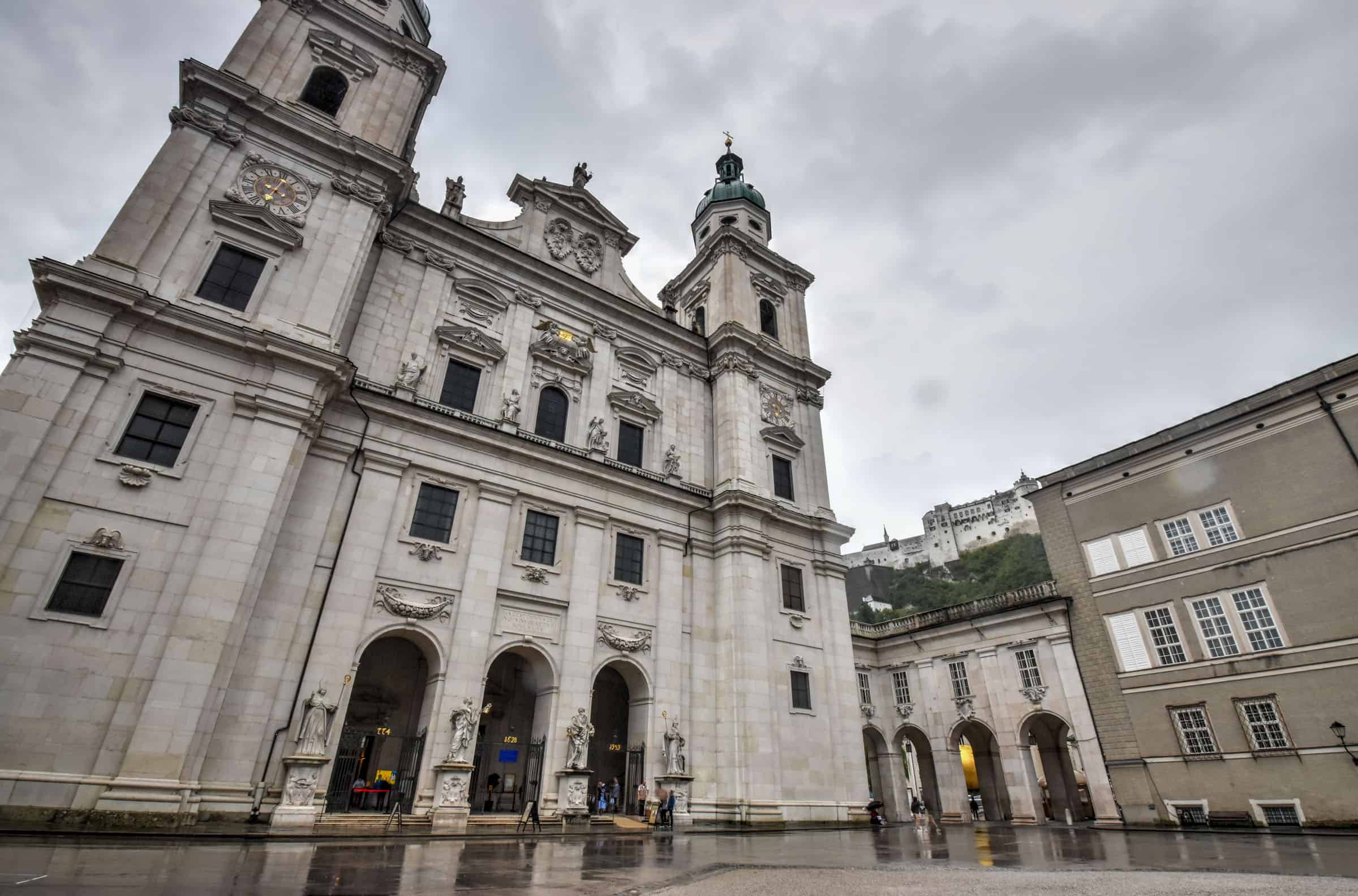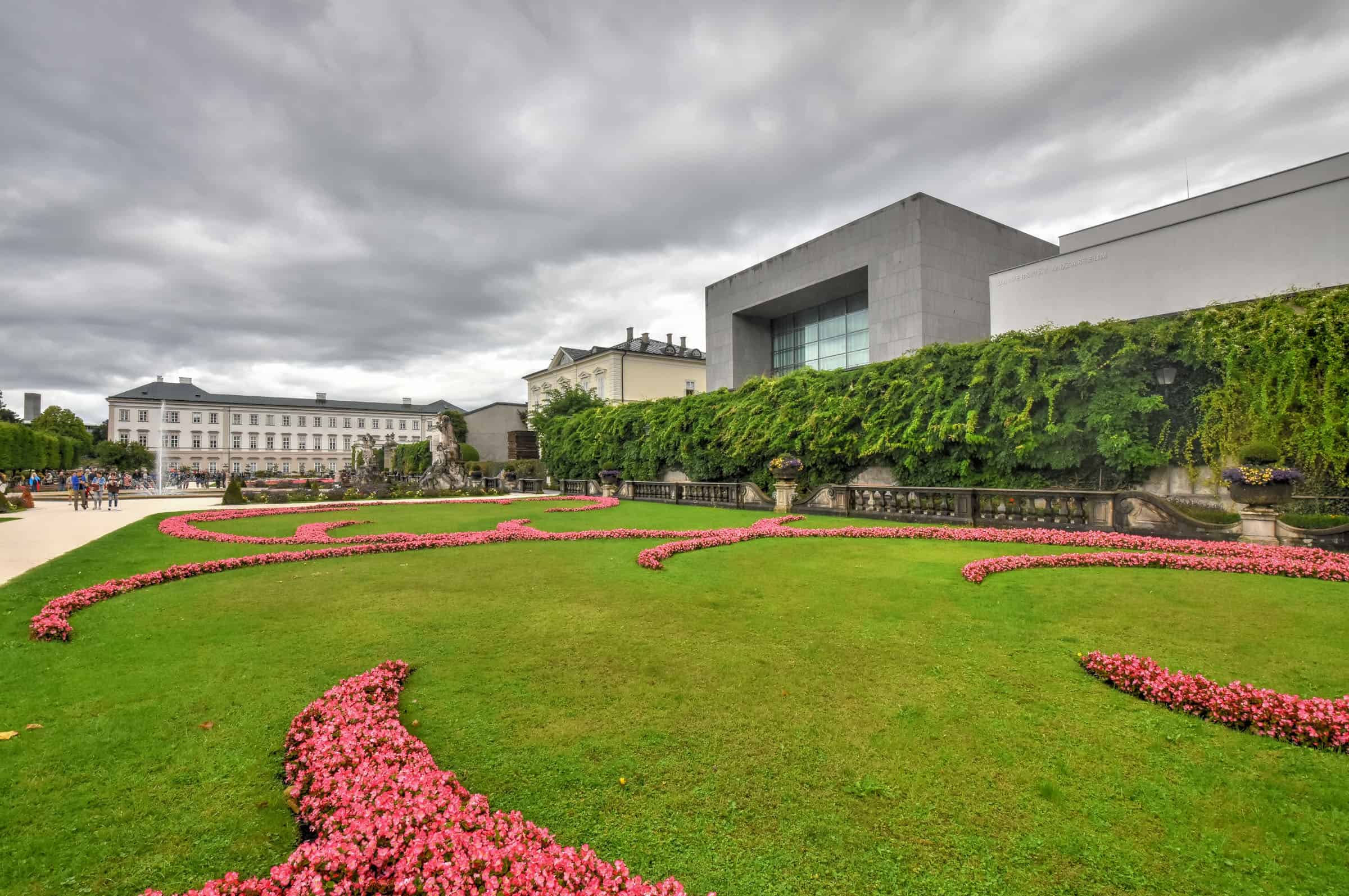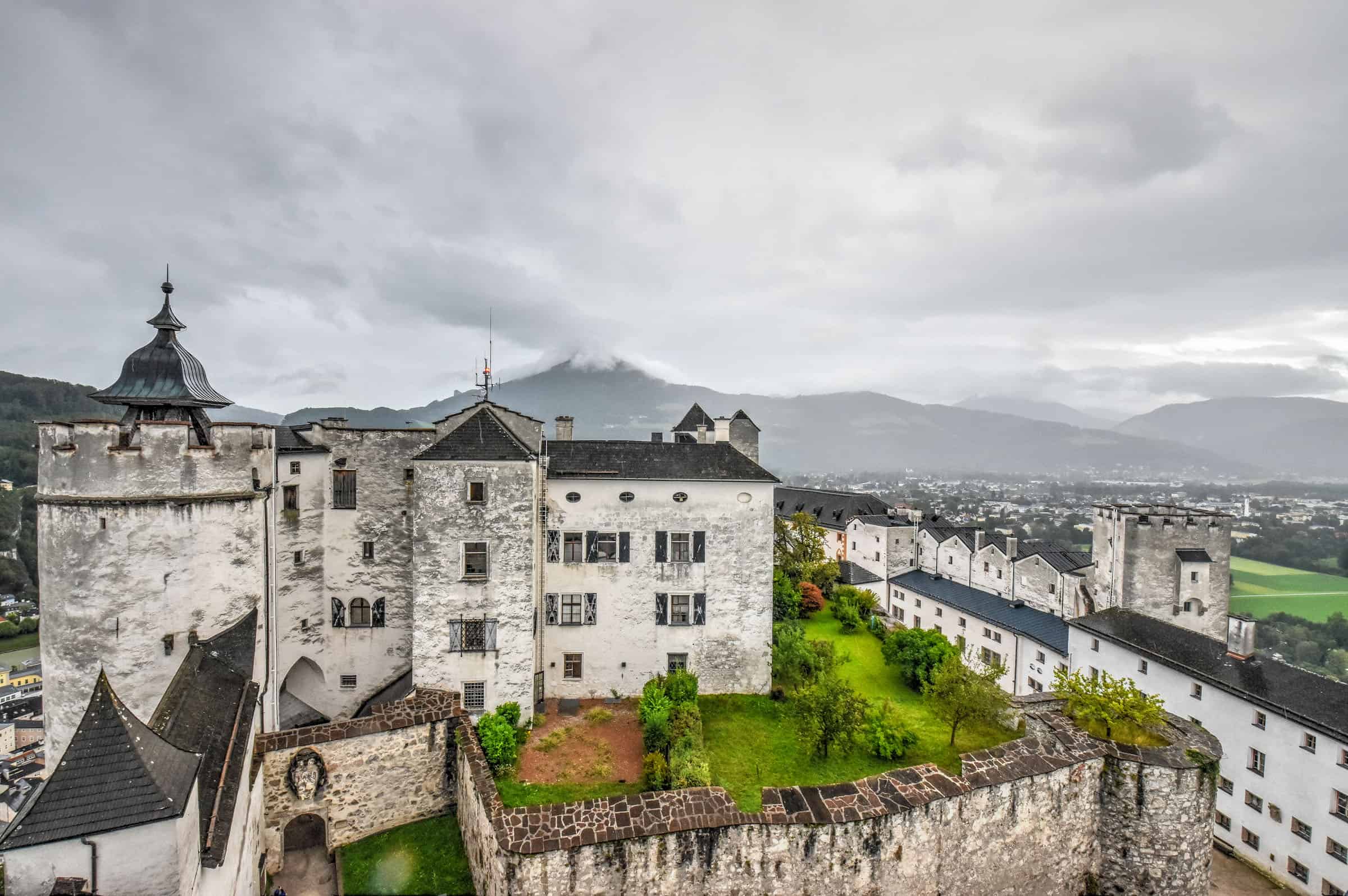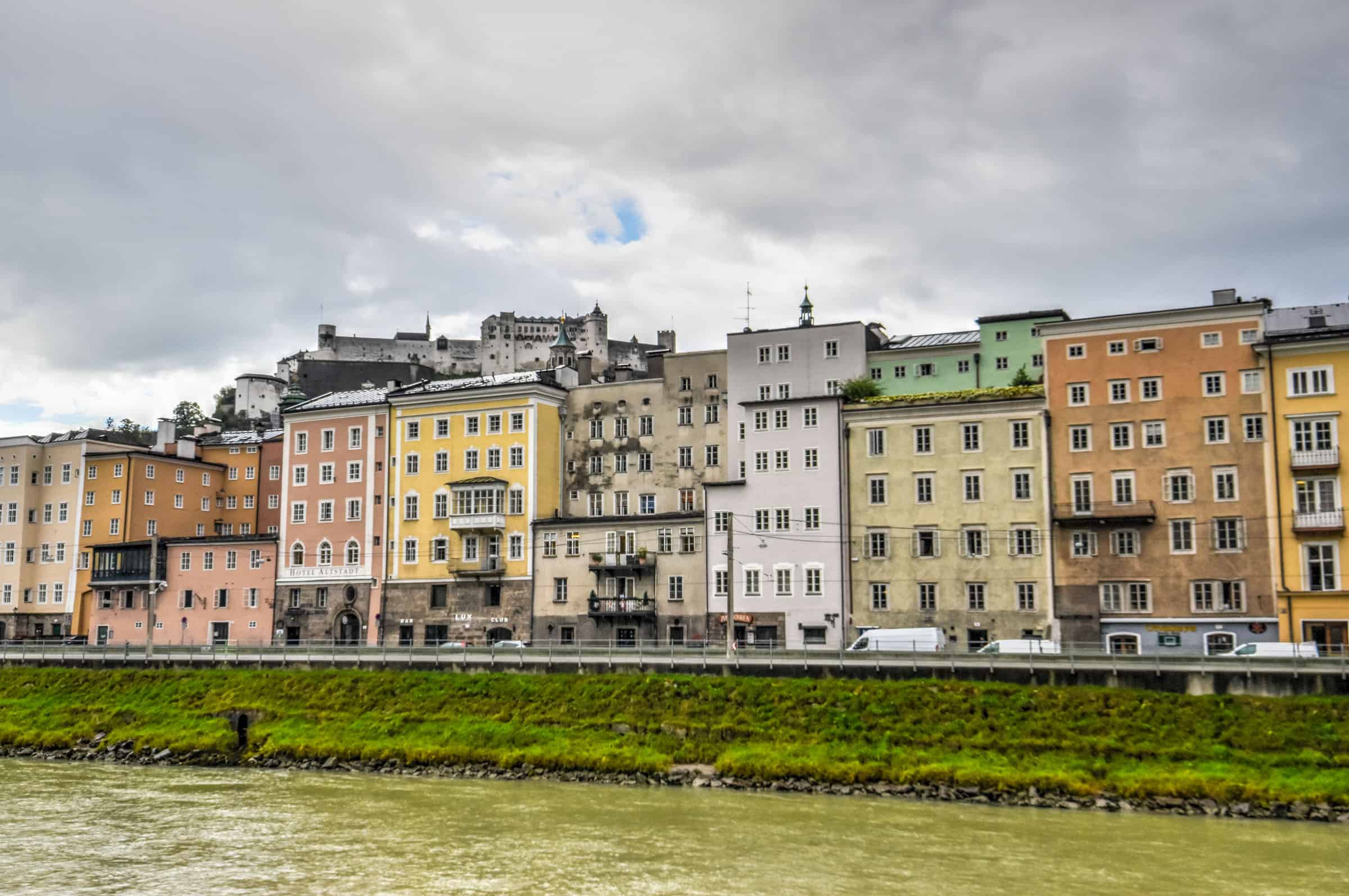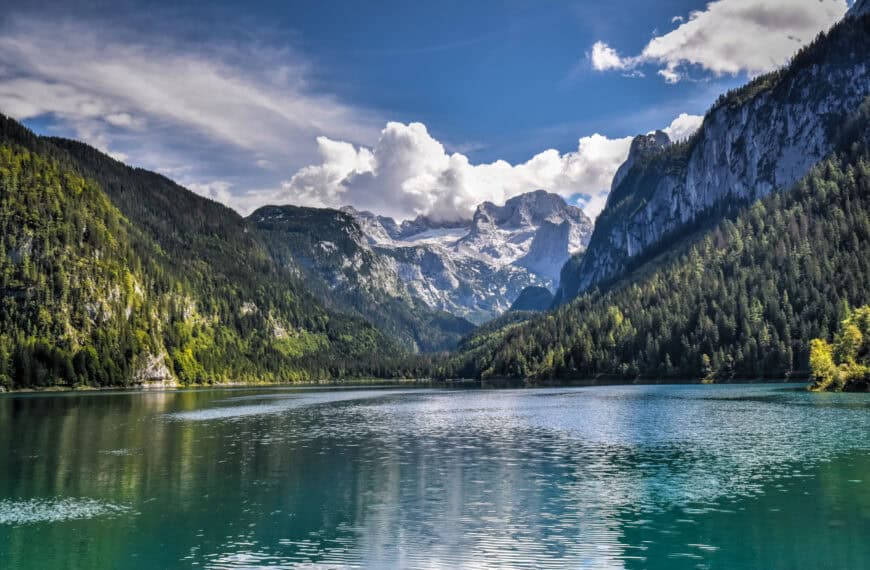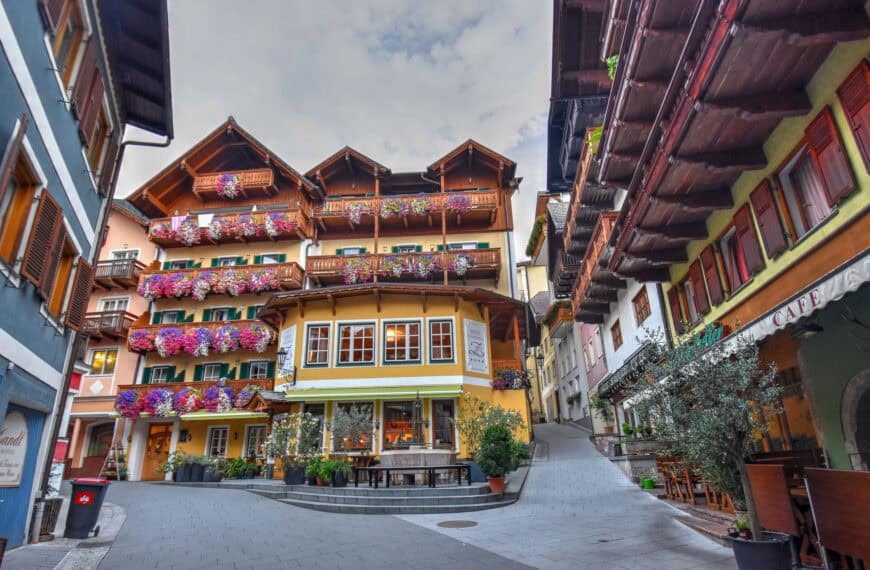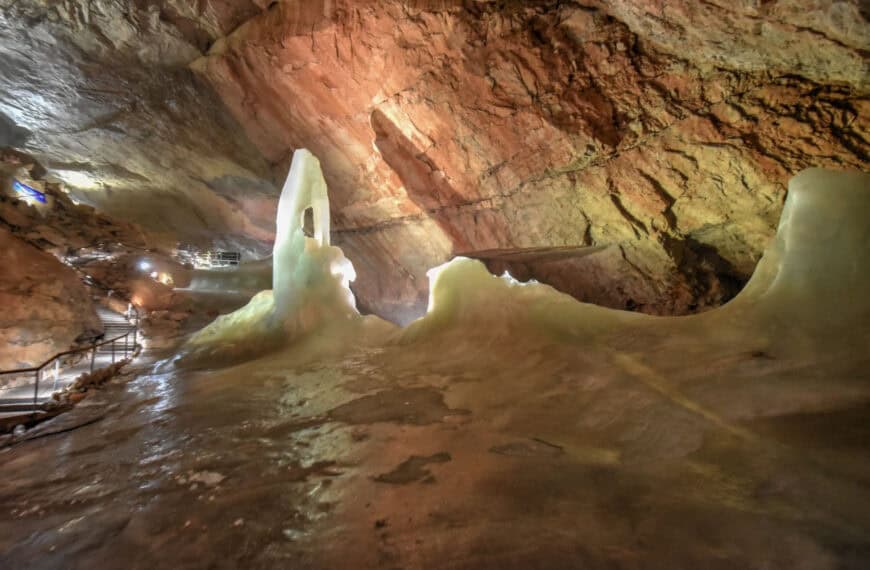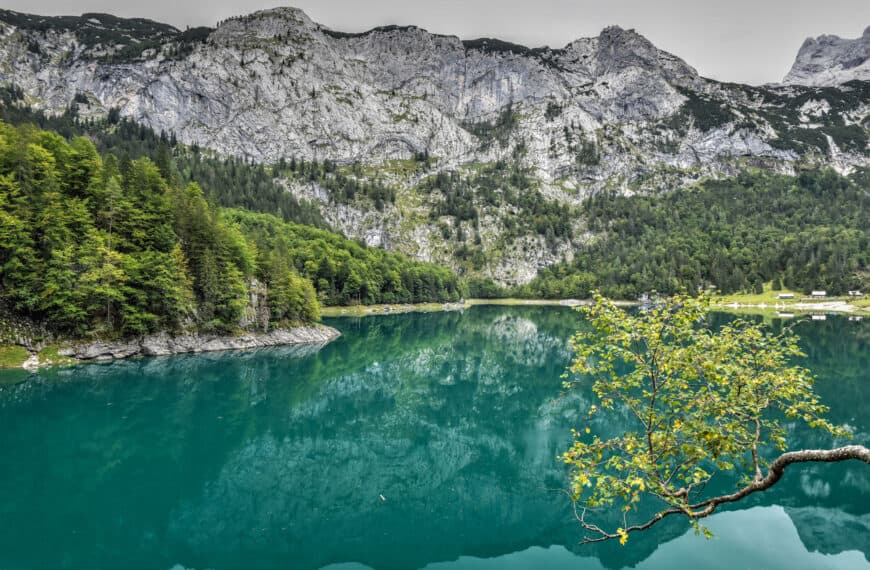Königssee is often considered Germany’s most beautiful alpine lake. Located in eastern Bavaria near the border with Austria, it is definitely reminiscent of a Norwegian fjord due to its elongated shape and being nestled between towering mountains. It’s a great place to not explore by boat, but also to do some hiking. A fun hour-long ride on electric-powered boats will take you across the lake to its southern point, from which you can undertake a relatively easy hike around the scenic Obersee (a beautiful small lake south of Königssee), through cattle pastures and eventually to Germany’s tallest waterfall, Röthbachwasserfall. If that wasn’t enough, you can also visit a stunning old pilgrimage church from the late 17th century, St Bartholomew, which can only be visited by boat (or via a very long hike) along the lake’s scenic western shore. To help you plan the perfect trip to this area of Berchtesgaden National Park, we put together this travel guide on Hiking to Obersee with a Königssee Boat Tour.
Disclosure: This page (Hiking to Obersee with a Königssee Boat Tour) may contain product affiliate links. At no additional cost to you, we may receive a commission for purchases made through these links. More details can be found on our disclosure and policies page.
You might also be interested in these pages:
Best Things to See and Do in the Salzkammergut
Perfect Road Trip Itinerary in the Salzkammergut
Best Things to See and Do in Salzburg
Best Things to See and Do in Hallstatt










Orientation – Königssee Location
Königssee is roughly located within Berchtesgaden National Park, which itself is located in the southeastern tip of Bavaria, near the German border with Austria.
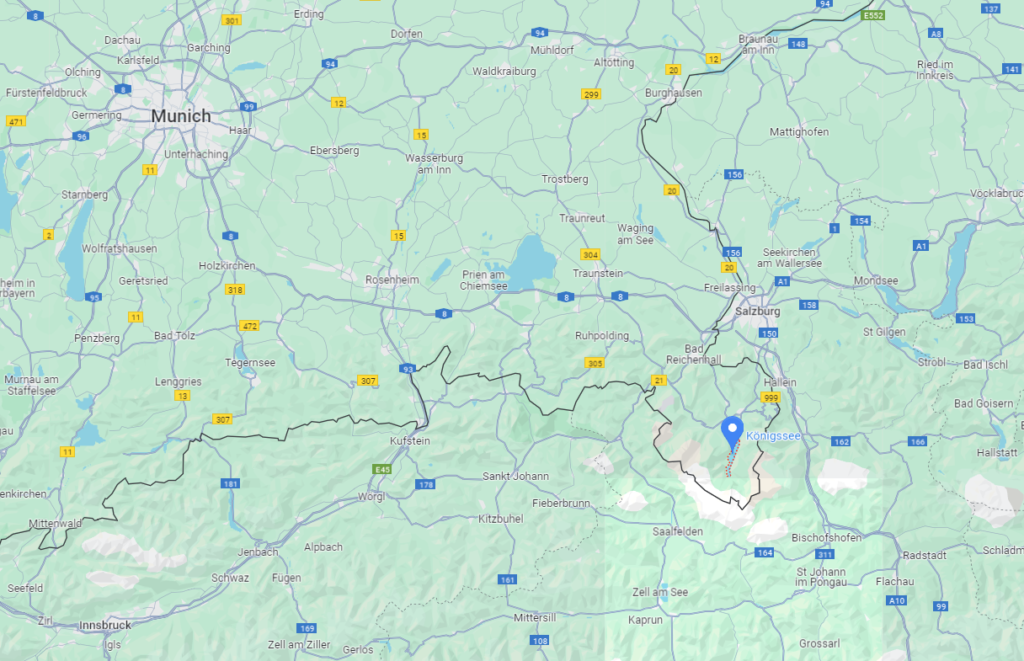
Königssee and Berchtesgaden National Park can be easily visited as a day trip from Salzburg (or Hallstatt). They can also be visited from Munich and Innsbruck, which are both slightly more than 2 hours away, so an overnight stay in the area might be preferable if departing from one of those two cities.
Regardless of where you are visiting from, it will generally not only be quicker and more straightforward by car, but you will also enjoy greater flexibility and ease of travel if you wish to visit other nearby attractions.
By Car: From Salzburg, it’s about a 35-minute drive (30km) to Königssee. From Hallstatt, it’s about a 1h20 drive (90km). From Munich, it’s about a 2h15 drive (160km), and from Innsbruck it’s about a 2h20 drive (160km).
If you need to book a rental vehicle for your travels, we highly recommend using Discover Cars to get the best rates on your rental in Austria or Germany.
We also highly recommend Airalo (eSIM card) for your connectivity needs when travelling abroad. Airalo is the world’s first and largest eSIM store with eSIM plans for 200+ countries and regions worldwide.
Important: All Austrian motorways (“Autobahn”) and expressways (“S” roads) are subject to tolls. All cars, motorbikes and camper vans must either properly display a toll sticker or have purchased online a digital vignette when they plan to drive onto a motorway or expressway. Vignettes with periods of validity of 10 days, 2 months or 1 year are available from more than 6,000 outlets in Austria and neighbouring countries, and digital vignettes can be purchased from the ASFINAG website. They are not prohibitively expensive — for instance, the 10-day vignette for cars costs €11.50.
By Bus/Train: From Salzburg, you can take the 840 bus to Königssee (1 hr). From Munich, there are several bus and train options, most of which will take about 3 hours, about the same amount of time it would take you from Innsbruck. The public transit options from both Munich and Innsbruck will require at least two transfers.
By Group Tour: This can be a great option if you don’t want to deal with the transit logistics while benefiting from a time-efficient direct route between Salzburg (or Munich) and Königssee (see tour image links below).
Arrival by Car and Parking:
There’s a large car park near the lake, about a 5-minute walk from the boat tour terminal.
The public car park is operated by the municipality of Schönau am Königssee. It’s best to pay for a full-day ticket (9.00 €, (2024 price)). The other options are 3.00 € for up to 1 hour or 7.00 € for up to 3 hours, neither of which is sufficient if you plan to do the full boat tour (roughly 2 hours + wait times) with a minimal amount of walking around and exploration. You can pay cash (exact amount only), with your credit card or with the Parkster app.
Note that on sunny summer days, the cark car tends to fill up by 10 am. As such, it’s best to arrive early to guarantee a parking spot.
Other car park relevant facts:
-Parking fees are payable 7 days a week from 7:00 a.m. to 7:00 p.m. Overnight stays in vehicles are not permitted
–A Tourist information kiosk is located next to the Königssee car park
-Smaller lockers (deposit €2.00) for backpacks, motorcycle helmets, etc. are located behind the motorcycle parking area
-Free public toilets are available next to the tourist information office
About Königssee
Königssee is known for its clear water and is often advertised as the cleanest lake in Germany. For this reason, only electric-powered passenger boats and rowing boats have been permitted on the lake since 1909.
It’s also Germany’s third deepest lake, stretching about 8 km in the north-south direction and is about 1.7 km across at its widest point. The lake exhibits fjord-like features, as it’s surrounded by the steeply-rising flanks of mountains up to 2,700 m (8,900 ft), including the Watzmann massif in the west.
Swimming and Boat Rentals
You can swim at Königssee – as long as you stay out of the tour boat lanes.
Apart from taking a tour boat, you can rent row boats (€15 per hour) from this location near the boat tour terminal (Königssee Seelände). All other forms of transportation (paddle boats, inflatable boats, canoes, SUPs, air mattresses etc. are prohibited)
Planning Your Visit
For most people, the visit to Königssee has up to four main attractions: 1) the boat tour, 2) the visit to St. Bartholomä, 3) the short hike to and around Obersee, and 4) continuing the hike to Röthbachwasserfall.
The first step is getting on one of the Königssee boats, as all the other steps require you to make it to other parts of the lake. The boat makes use of three* different docking piers on the lake: Königssee Seelände (departure), St Bartholomä (where you can visit the church), and Salet (for the Obersee & Röthbachwasserfall hike).

*There’s actually a fourth potential stop: Kessel. This is on request only and for those who want to complete an arduous hike (20km trail with 1285m in elevation gain). Also note that south and north are flipped in the above map – so boats depart from the bottom (north). (map source: seenschifffahrt.de)
Therefore, to see all of the attractions and return to your starting point you’ll need to get on the boat three times (Königssee Seelände <-> St Bartholomä, Königssee Seelände <-> Salet, St Bartholomä <-> Salet). The boats always stop at St Bartholomä in between Königssee and Salet, you simply won’t get off one of the times.
Trips from the Königssee Seelände to St Bartholomä take approximately 35 minutes, whereas trips to Salet take approximately 55 minutes. In total, you can expect to spend about 2 hours on the water.
We recommend that you first take the boat all the way to Salet (and not get off at St Bartholomä) to start with the hikes to Obersee and/or Röthbachwasserfall for time-management purposes since it’s difficult to predict exactly how much time you will spend on the hike. Afterwards, it will be easier to decide how long you want to spend at St Bartholomä before taking a final boat to head back to the Königssee Seelände.
We also recommend getting on one of the first boat tours of the day (if not the first one). As the day advances, lines can form to take boats back to Königssee Seelände (regardless of whether you are at Salet or St Bartholomä), meaning you might not be able to board the return boat you intended to. If you come by bus from Berchtesgaden, there will likely be long lines later in the day for the return bus as well.
When to Visit Königssee
To enjoy nice weather with fewer crowds while taking full advantage of what the area has to offer, we definitely recommend shoulder season (early June, September and early October) – the boat tours run from late April until mid-October. We visited in mid-September and felt that it was the perfect time to do so (even if it was rather overcast and drizzly during our visit).
The Königssee Boat Tour
Since 1909, Lake Königssee’s boats have been electrically operated. Today, the fleet consists of 19 (almost identical) electric motor boats (EMB), which run on batteries that are charged overnight. During the day, the eco-friendly boats glide silently over Lake Königssee at an average speed of 12 km/h. Each boat is about 20m long, 3.50m wide and can carry around 93 people. There are no toilets on the boat, but there are public toilets near all three boat docking ports (including the departing one). All boats depart from the lake’s northern Königssee pier, by the ticket office.


Boat Tour Costs: The ticket cost depends on where you intend to visit. You can purchase a round-trip to St. Bartholomä for 22,50 € (2024), or purchase a round-trip ticket to Salet (for the hike to Obersee and Röthbachwasserfall) that also includes a stop to St. Bartholomä for 28,50 € (2024 price). Children (6-17) can travel at a 50% discount.
Dogs are permitted on the boat (5 €) but must wear a muzzle at all times.
It is not required, but you can purchase tickets online in advance here. However, note that tickets purchased online cannot be cancelled or exchanged. Also, not all tickets are made available for online purchase, meaning that they will never sell out ahead of time.
Boat Tour Seasonal schedule: The boats run from late April until mid-October.
Boat Tour Daily timetable: The exact timetable depends on the time of year (source: seenschifffahrt.de)

Boat departure intervals are by default every 30 minutes, but additional departures can be added during busy days.
Some views from the boat:






Views of Salet Pier
Views of Königssee Seelände pier
Views of St Bartholomä pier
The Hike to Obersee and Röthbach Waterfall
Once you debark at Salet pier, you will first cross a small visitors center with public washrooms, and shortly thereafter, Saletalm, an alpine hut-like self-service restaurant (no overnight stays however).



Once you pass the hut, you are essentially along the hiking trail towards Obersee. Most people will walk to one of two potential endpoints: 1) The end of Obersee Lake and Fischunkelalm mountain hut or 2) all the way to Röthbach Waterfall.
1. Obersee Lake and Fischunkelalm mountain hut
Distance: 5.5 km
Route Type: Out & Back
Elevation gain: 150 m
Start point: Salet pier
AllTrails rating: (4.7, 48 ratings (2024))
Duration: Most people complete the trail in about 1h15-1h30
Access Fees: Free
2. To Röthbach Waterfall
Distance: 8.5 km
Route Type: Out & Back
Elevation gain: 260 m
Start point: Salet pier
AllTrails rating: (4.6, 136 ratings (2024))
Duration: Most people complete the trail in about 2h30-3h
Access Fees: Free
*note that the elevation gain for both trails from AllTrails is wrong for some reason. The true number is closer to the number posted in the boxes above the maps, confirmed by us and several other users on the AllTrails website. These hikes are considered easy to moderate.
Not an AllTrails member yet? We highly recommend signing up for either their free or paid membership plans. The free plan allows you to find new trails and plan routes but it can only be used while hiking if you have access to mobile data. The paid membership plan (AllTrails+) allows you to download trail maps for offline use and provides live progress updates and off-route notifications.
If you are still uncertain – you should know that the All Trails mobile application was voted the 2023 iPhone App of the Year by Apple.
Once you depart from Salet, heading south, you can reach the northern shore of Obersee in about 15 minutes along a wide, flat gravel trail.
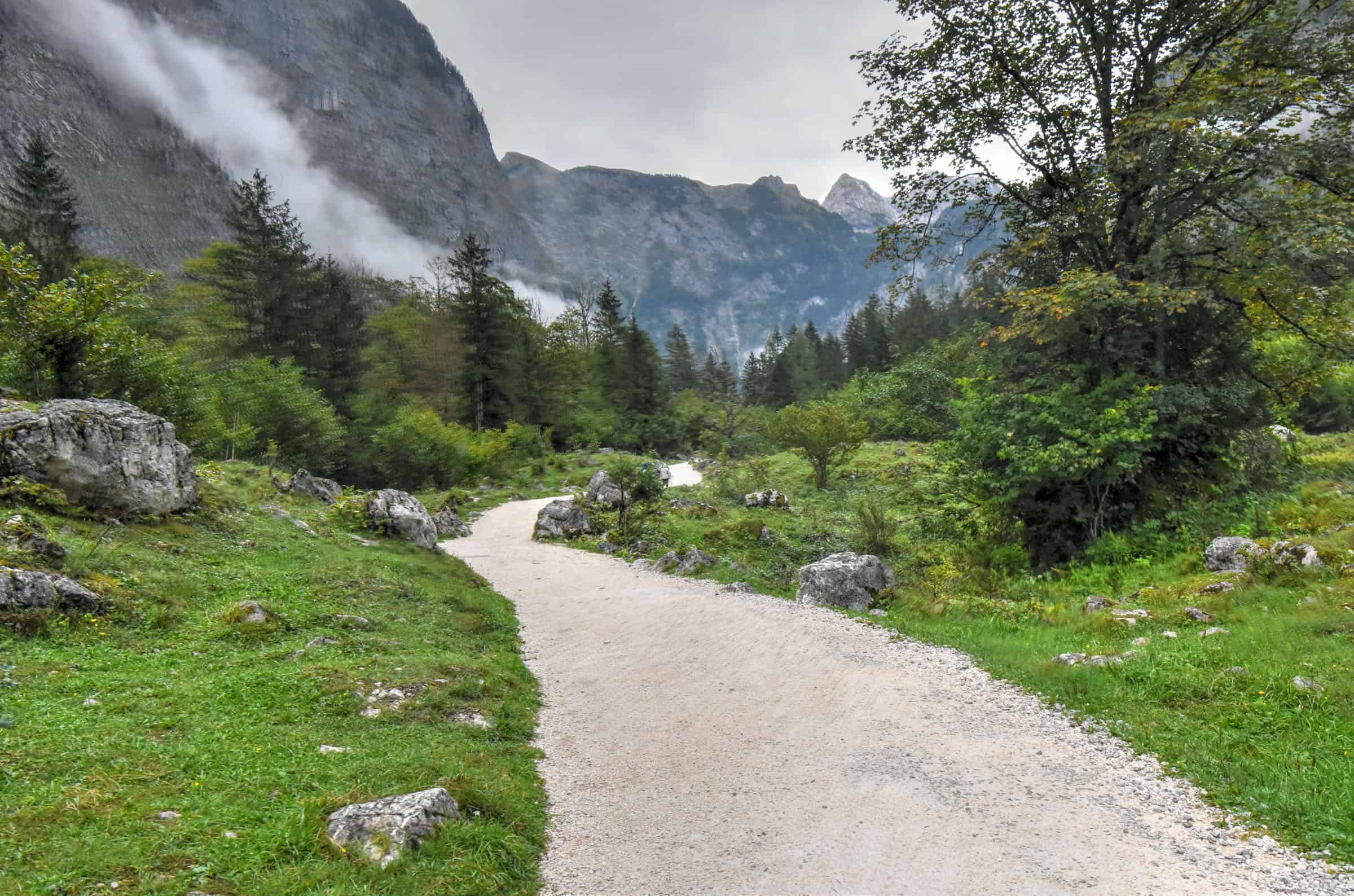
You will quickly be struck by the beautiful scene created by the boat house, the emerald waters and the towering mountains in the backdrop.



From there you will start to loop around the lake along its western flank and the trail becomes slightly more rocky as you gain elevation, but the trail remains relatively easy and perfectly safe, with occasional protective railings (as seen below). The views from this part of the trail are quite spectacular.





Once you have made it around the lake, you will have reached Fischunkelalm, another mountain hut serving refreshments and snacks for the famished hiker.





Many will choose to return back to Salet from this point, but more fun definitely awaits if you continue onwards. The path becomes more even and rocky at this point (and potentially muddy under heavy rains), but you will be passing through scenic cattle pastures, with the narrow but towering Röthbachwasserfall – Germany’s tallest waterfall with a vertical drop of 470 metres.



Once you’ve taken time to soak in the waterfall views, it’s time to return to Salet, to take the next boat to St Bartholomä.
Hiking Packing List
All Trails subscription – This comes in really handy for areas with little or no cell reception, as the annual subscription allows you to download trail maps for offline use.
External Battery – If you are using your phone to track your progress along the trail or to help with navigation, you certainly don’t want your phone to die on you. That’s especially true in the unlikely event that you might get hurt or need assistance.
Hiking poles – These can be particularly useful in steep trails or muddy/boggy trail conditions.
Water Filter Bottle – The Life Straw bottle is an advanced water bottle with a filter that not only improves water taste but more importantly filters out bacteria and parasites, chemicals and microplastics.
Headlamp – very practical and a smart choice if you plan to start your hike before sunrise or finish it after sunset.
St Bartholomä Church
St. Bartholomä (St. Bartholomew’s Church), is a famous pilgrimage church located on a peninsula about halfway down the western lake shore – one that can only be accessed by boat (or after a long hike across the surrounding mountains). The first chapel at the lake was built in 1134 by the Provosts of Berchtesgaden. In 1697 it was rebuilt in a Baroque style with a floor plan modeled on Salzburg Cathedral, two onion domes and a red domed roof.



Around the church, you’ll find the following: a seafood restaurant, and inn (formerly a hunting lodge and royalty residence before that), a tourist-visitor center, public washrooms, and lots of short walking trails that are either along the shoreline or under forest cover, including a few that turn into longer-distance and challenging hiking trails into the mountains.








We wandered around here for about an hour before returning to Königssee Seelände, as we had a late afternoon booking to visit the Berchtesgaden Salt Mine (Salzbergwerk Berchtesgaden – more on this below).
Other Sights and Attractions Near Königssee
Visit the Berchtesgaden Salt Mine (Salzbergwerk Berchtesgaden)
The Berchtesgaden Salt Mine is only a short 10-minute drive from Königssee (only 30 minutes from Salzbug). We found the tour to be a fun learning experience about the history of salt mining in the area – not to mention the underground mining train rides, the boat ride across “Mirror Lake”, a subterranean salt lake, and the 36-meter-long miner’s wooden slide.
Berchtesgaden Salt Mine started operations in 1517 – and has continued uninterrupted to this day. A miner’s train will take you 650 meters (2,133 feet) into the mountain itself, where a gigantic salt cathedral with a spectacular miner’s slide awaits. Various multimedia installations depicting the mining of salt are presented throughout the one-hour guided tour.
The salt mine is located within the town of Berchtesgaden, about a 10-minute drive from Königssee. For more information, you can visit the mine’s official website. Advanced booking is recommended as the tours can sell out quickly. Unfortunately, photography isn’t permitted inside the salt mine, so to get a glimpse of what to expect here’s the mine’s official video:
Ride the Cable Car up Jenner Mountain
A short walk from the Königssee parking is the Jennerbahn, a small cable car that will take you to the top of Jenner Mountain. Home to ski trails in the winter, the area offers beautiful alpine walking trails and beautiful views of Königssee and the surrounding mountain scenery. For more information on cable car costs and timetables, you can consult the Jennerbahn official website.
Visit Eagle’s Nest
The Eagle’s Nest was built as a diplomatic teahouse for Adolf Hitler on Kehlstein Mountain. Its unusual location built up above Berchtesgaden at an elevation of 1,834 meters above sea level made it quite the engineering feat at the time. Built in 1937-38, the teahouse was intended to serve as a place of political representation, away from public view, and leave guests awestruck. Since 1952, the building has been used as a mountain guesthouse and has become a popular excursion destination.
Today the Eagle’s Nest houses a restaurant, an exhibit on the history about the History of the Eagle’s Nest, and a large terrace offering stunning panoramic views. In clear weather the views of the Bavarian and Austrian Alps are spectacular.
You actually can’t drive up to the Eagle’s Nest – it can only be reached by special bus that will drive up a steep mountain road, after which you will have to traverse a passageway that leads through a tunnel to an elevator which then carries guests up about 124 meters directly into the teahouse. For more information on visiting the Eagle’s Nest, you can consult its official website.
Visit Salzburg
Given Salzburg’s proximity to the Salzkammergut, it makes definite sense to visit this historic baroque town during your stay in the region. While many visit the Salzkammergut as day trips from Salzburg, many others do the opposite and visit Salzburg as a day trip from their base in the Salzkammergut.
Tucked away between scenic alpine landscapes near the German border and UNESCO-listed since 1997, the city has what many think is the best-preserved Baroque Altstadt (old town) and one of Europe’s best-preserved medieval castles towering above it. From the Sound of Music to Mozart’s childhood, the city has a rich cultural history and plenty of stories to share. Although the historic old town is fairly compact, its packed with attractions, museums and things to do. You can easily spend a full day here, if not more. The castle alone is worth a few hours.






For more information and tips on visiting this beautiful city, check out our travel guide on the Best Things to See and Do in Salzburg.
Planning a Trip to Austria?
You might be interested in these pages (coming soon):
Best Things to See and Do in the Salzkammergut
Perfect Road Trip Itinerary in the Salzkammergut
Best Things to See and Do in Salzburg
Best Things to See and Do in Hallstatt
We also highly recommend these guidebooks:
Rick Steves Vienna, Salzburg & Tirol
Lonely Planet Austria
Photography Gear
If you like our photography, you might be interested in some of the gear we use to shoot our travel and hiking destinations.
Camera Body – Nikon Z 6ii Fx-series Mirrorless Body
Main Lens – NIKON 24-120mm F/4G ED VR AF-S
Zoom Lens – Sigma 745-306 150-600mm f/5-6.3
Polarizing filters – Urth Circular Polarizing (CPL)
Camera Tripod – K&F Concept 64-inch Camera Tripod
Mini-tripod – Lammcou Flexible Camera Tripod
Camera/hiking backpack – Vanguard Alta Rise 48 Backpack
Universal Travel Adapter – VYLEE Universal International Power Travel Plug
Other Travel Essentials
Travel Insurance
SafetyWing is a travel insurance company that offers comprehensive coverage for travellers. Includes Medical Insurance and Travel Insurance. Primarily geared towards long-term travellers, digital nomads, and expats.
e-Sim cards
Airalo is the world’s first and largest eSIM store with eSIM plans for 200+ countries and regions worldwide. With Airalo eSIMs, travellers can get connected the moment they land at their destination and avoid nasty data roaming charges
eSIMS are a sustainable alternative to single-use SIM cards – they are 100% digital, require less energy to produce and be re-used rather than disposed of.
Car Rentals
Discover Cars is our go-to website for car rentals. We almost always find our preferred rate there.
Transfer from Airport
Welcome Pickups is our favourite private transfer service, which you can pre-book at a fixed price. Currently available in 220 cities all over the world (mostly in Europe, but with several major cities in Asia, the Middle East and the US).
Kiwitaxi is another private transfer service – we haven’t tried it yet, but it’s currently available in a few more countries (102 as of 2024).
Hotels and Accommodations (coming soon)
Photography Prints
If you found this blog useful, you can help support our blog by purchasing low-cost digital prints. Printed physical prints are also available for purchase.








—–
Well, that wraps it up! We hope you enjoyed our Guide to the Hiking to Obersee with a Königssee Boat Tour and that it will prove useful for planning your hiking trip.
—–
You might also be interested in these related pages:
